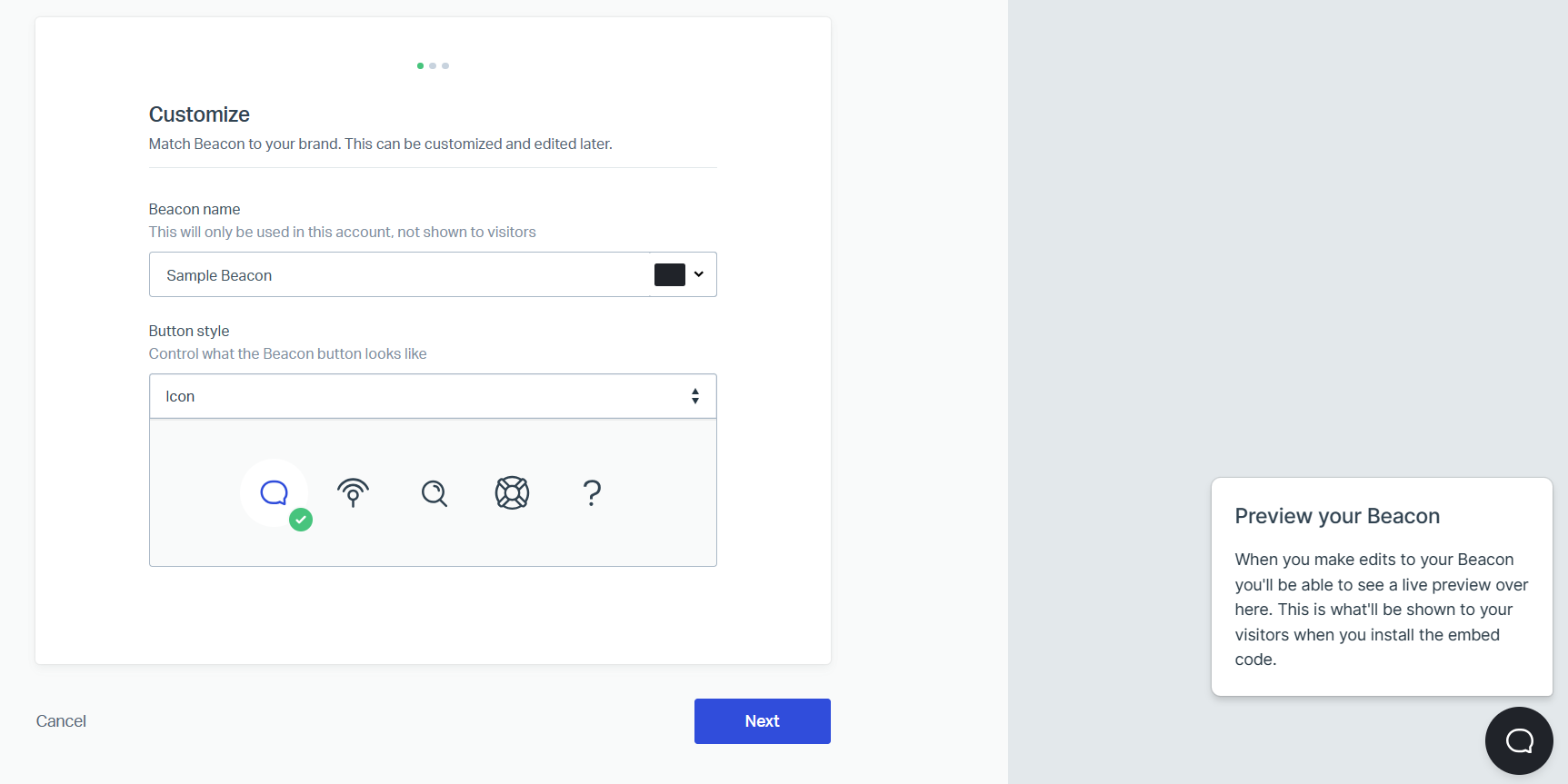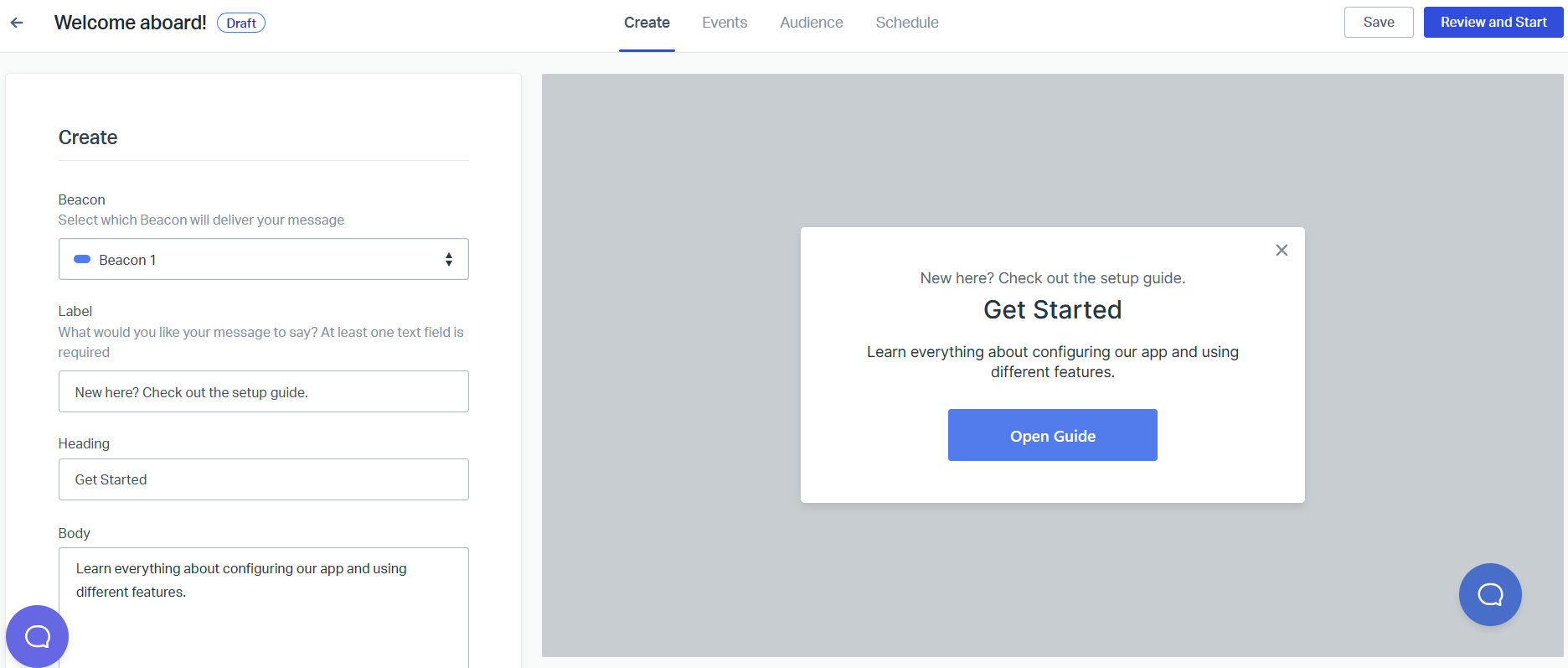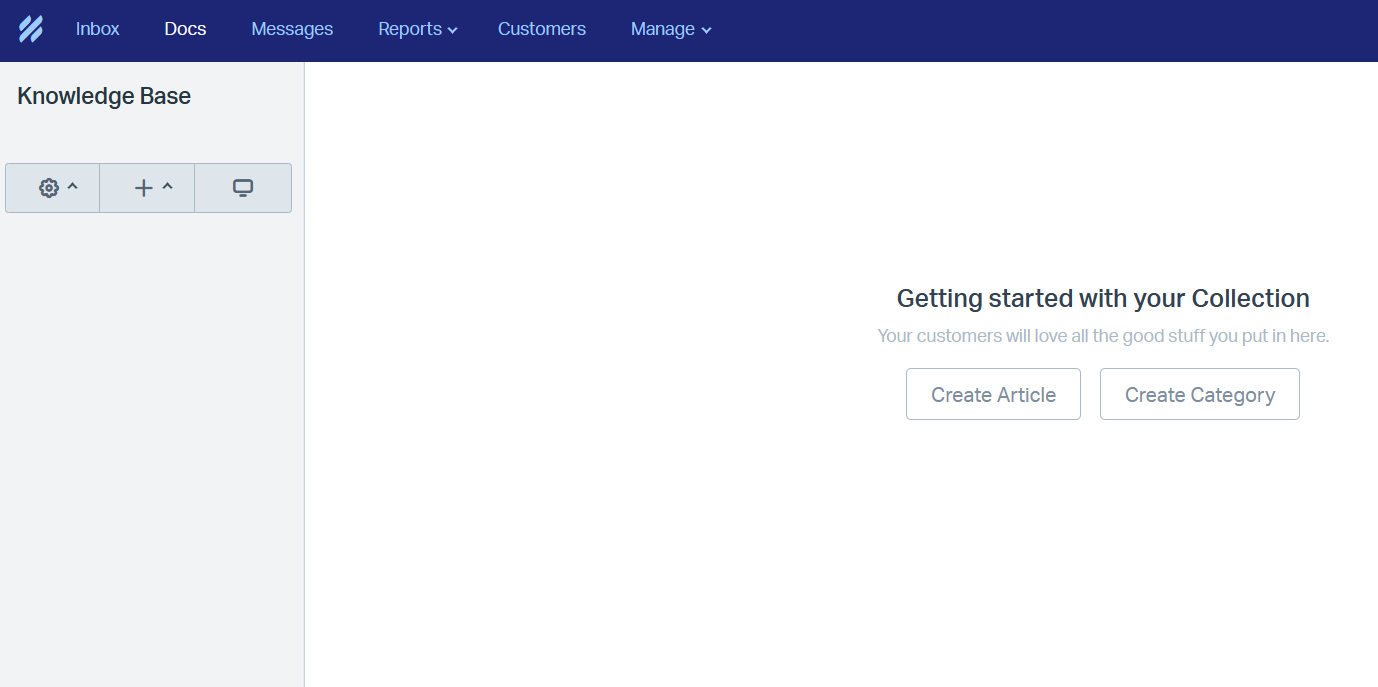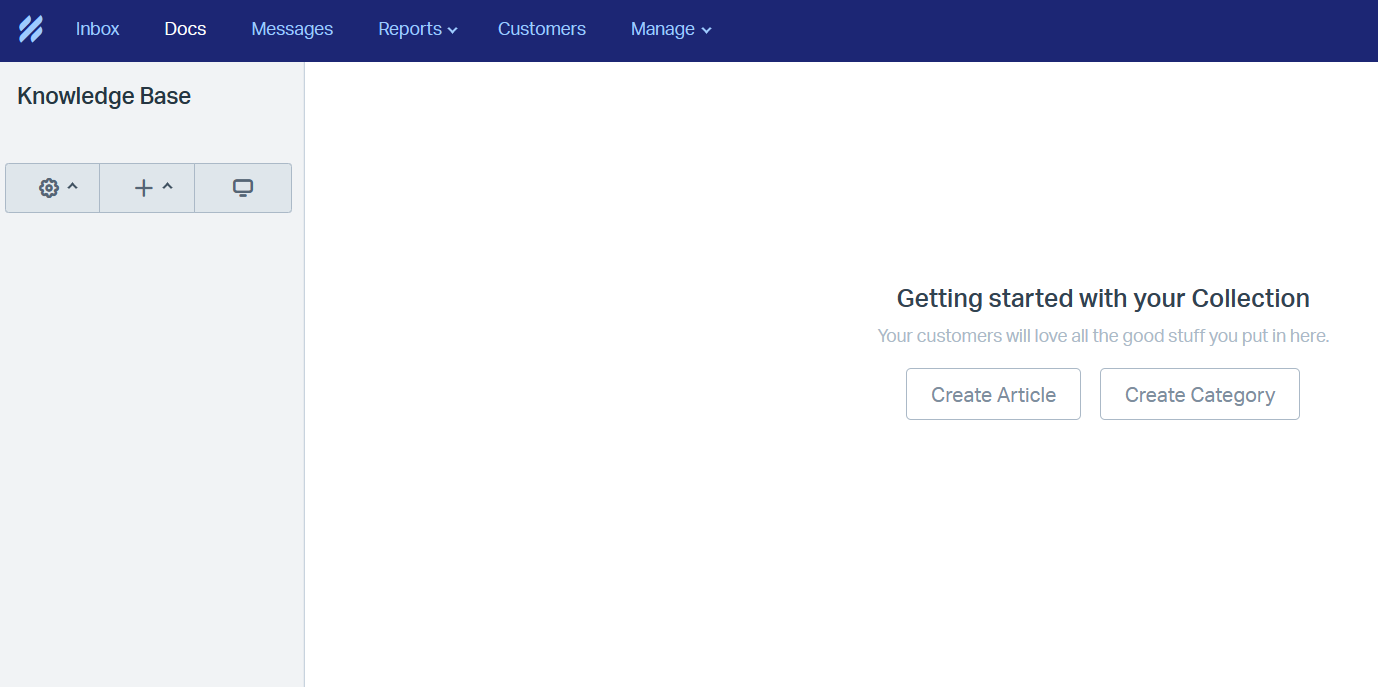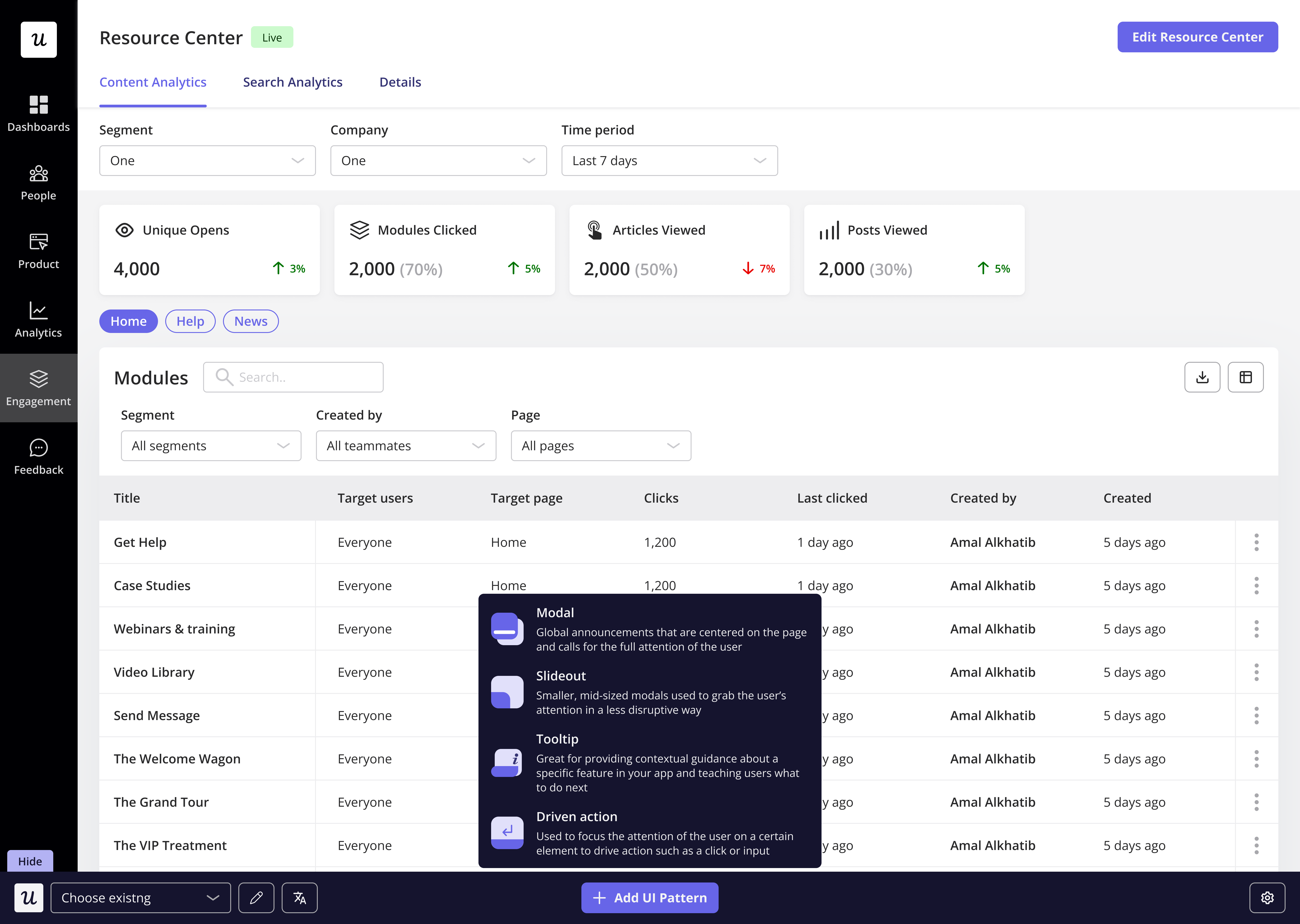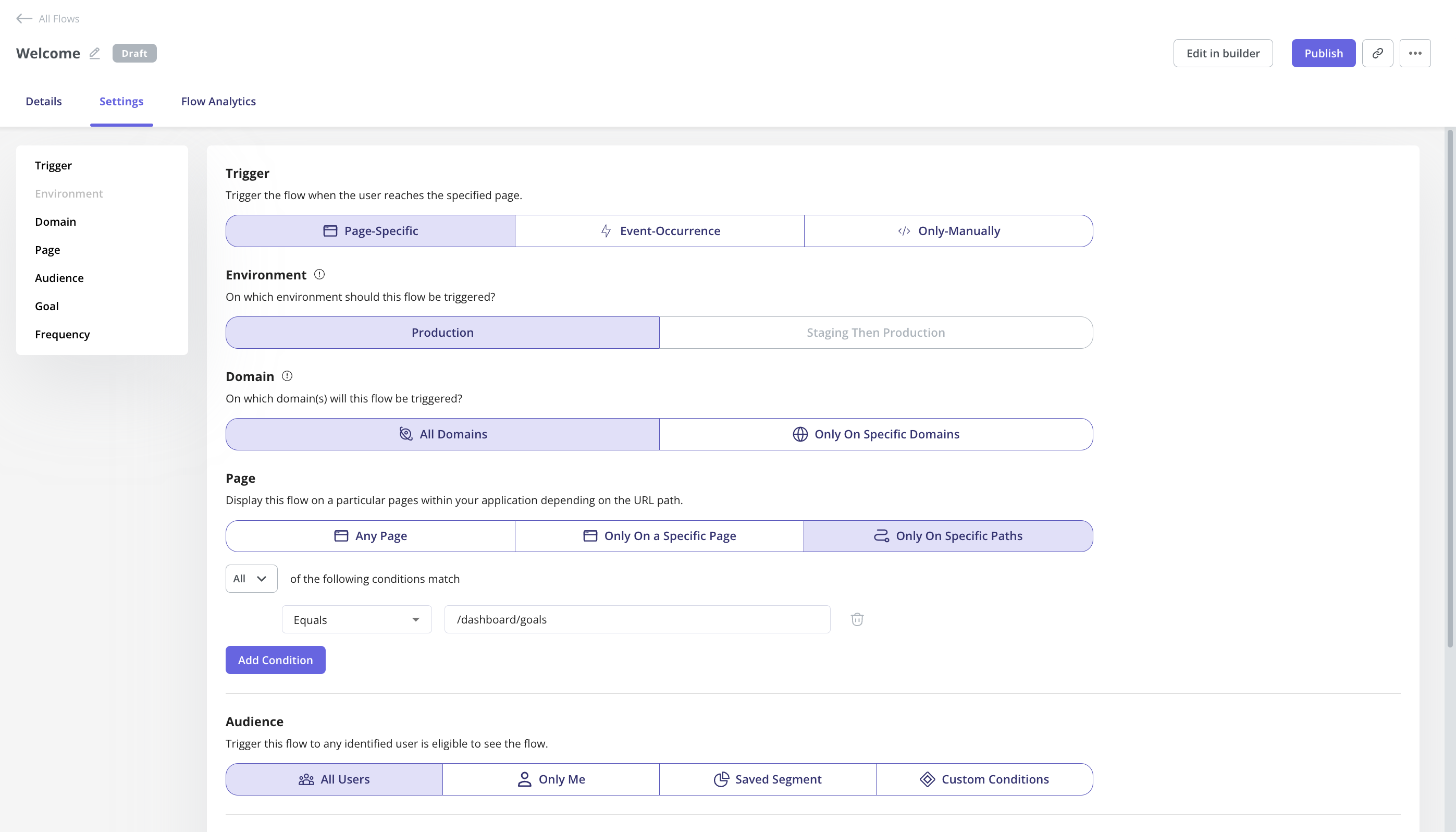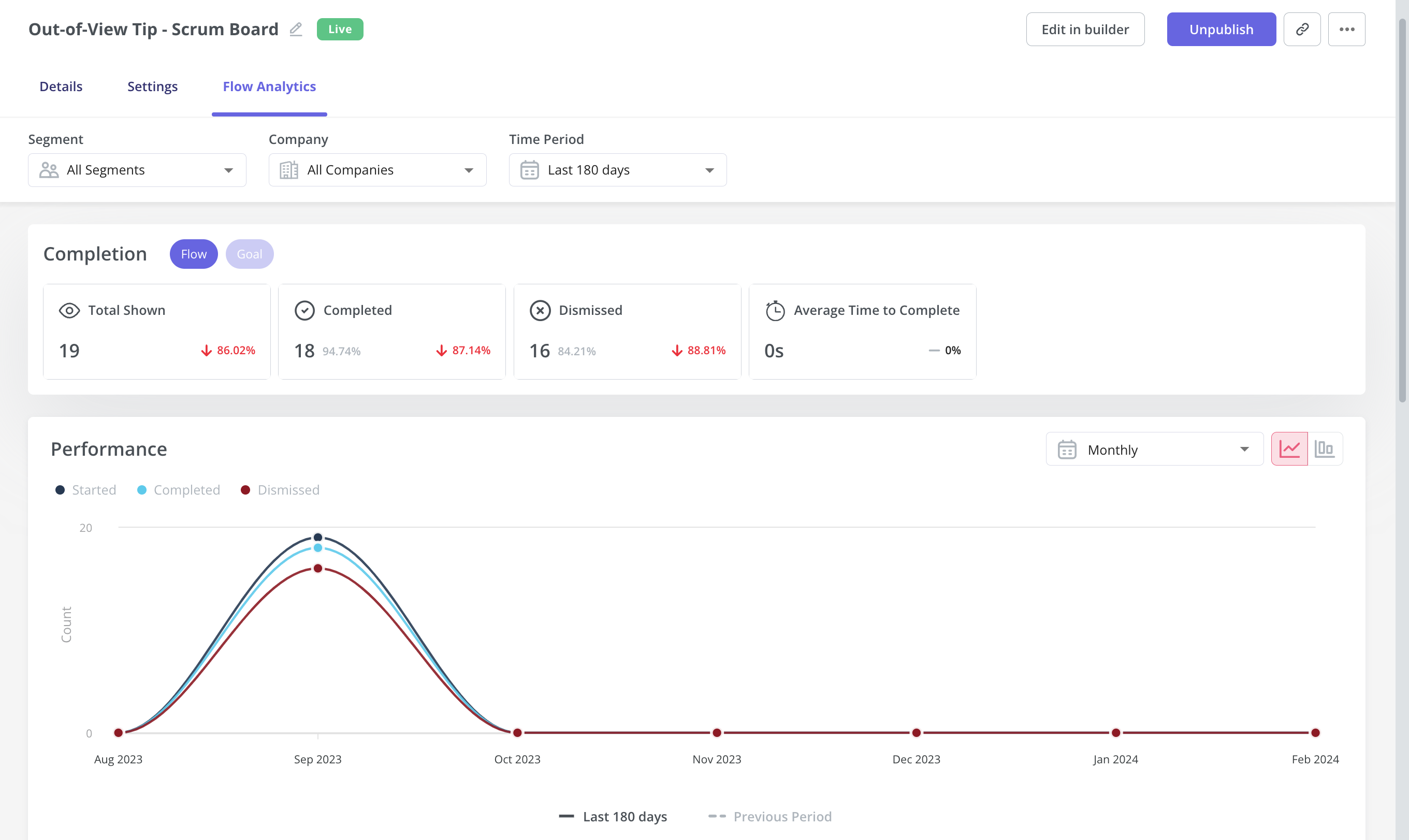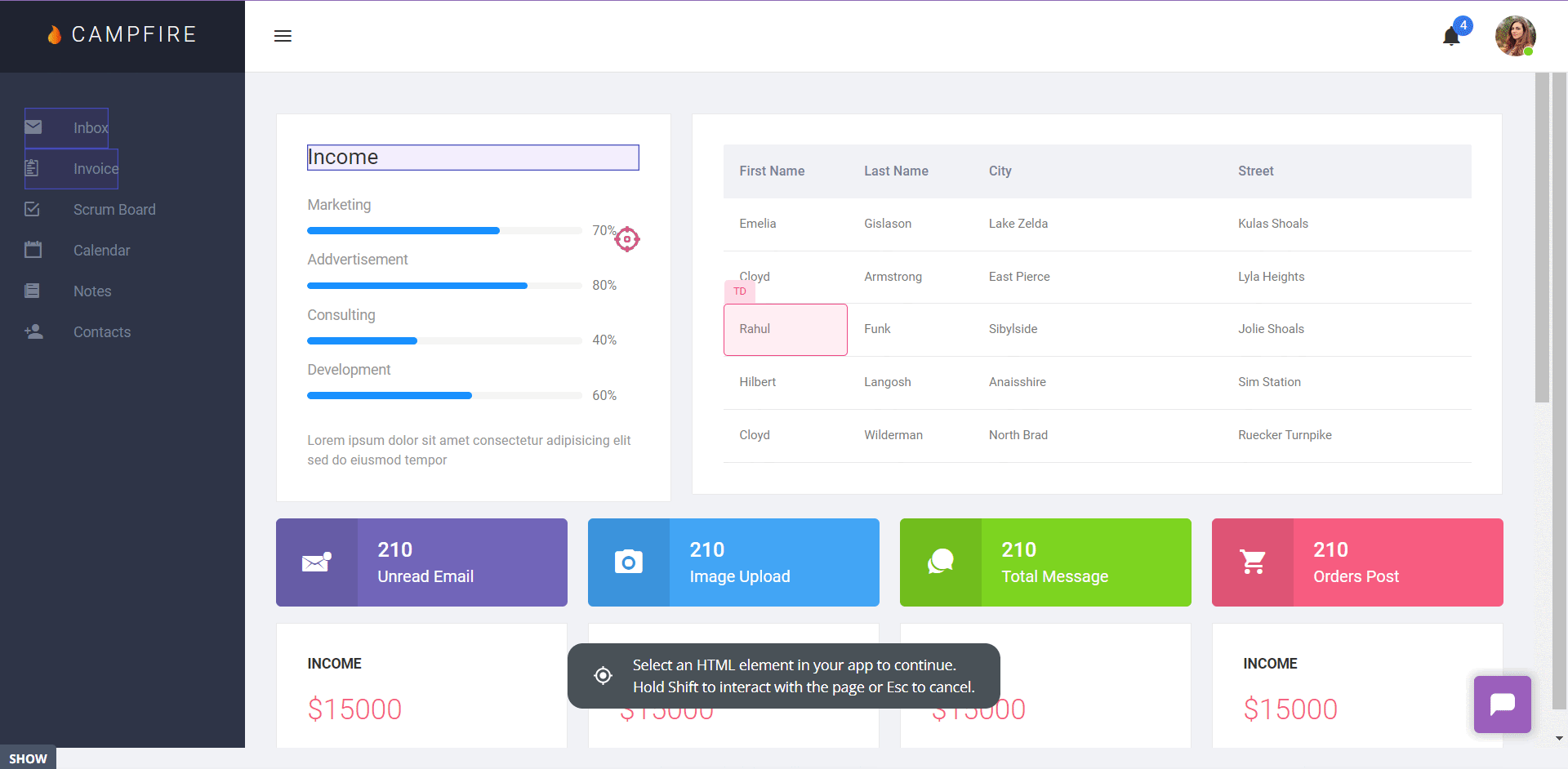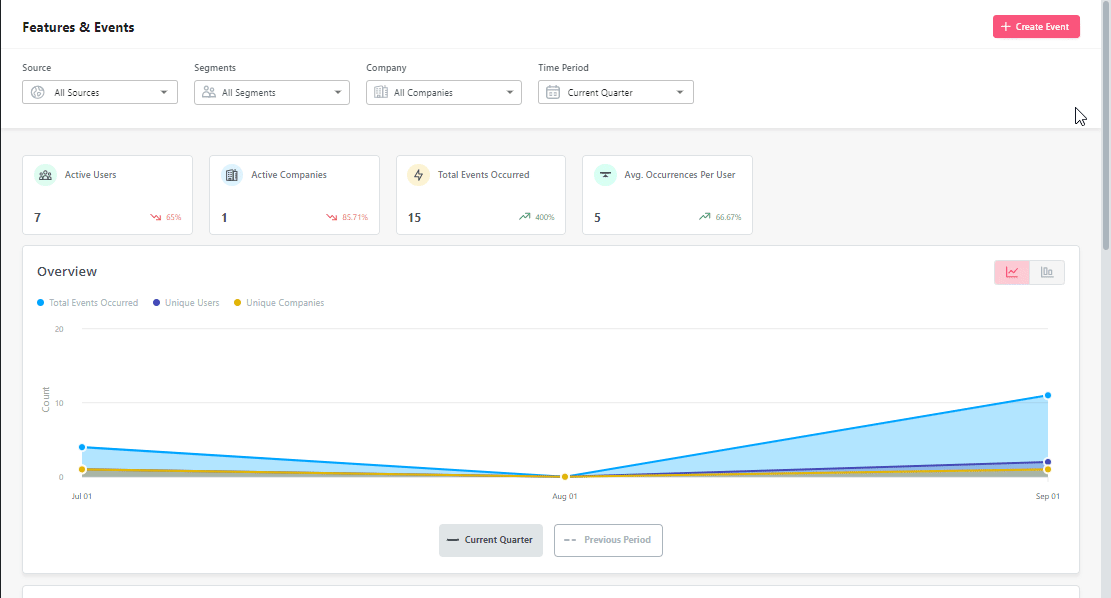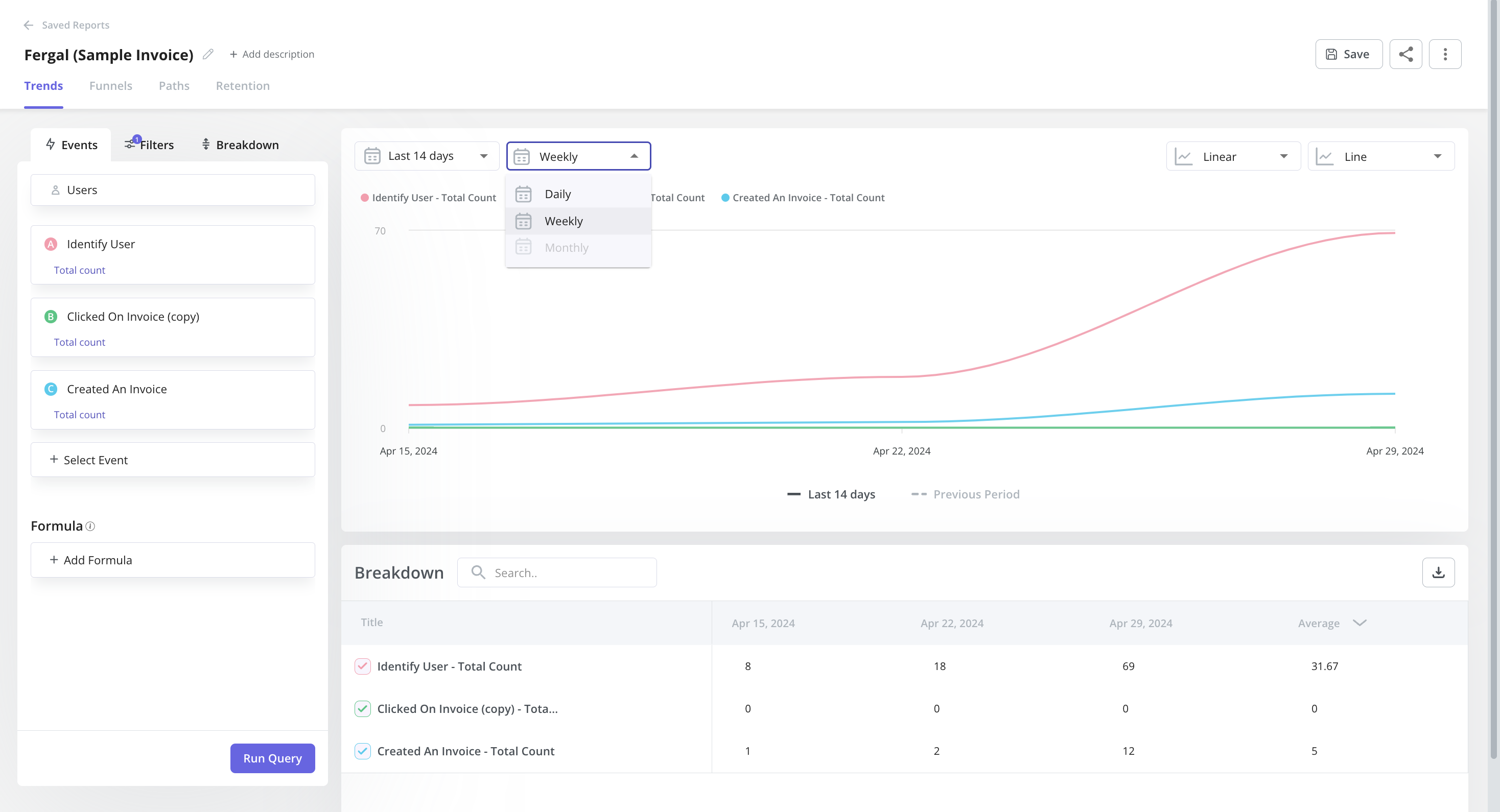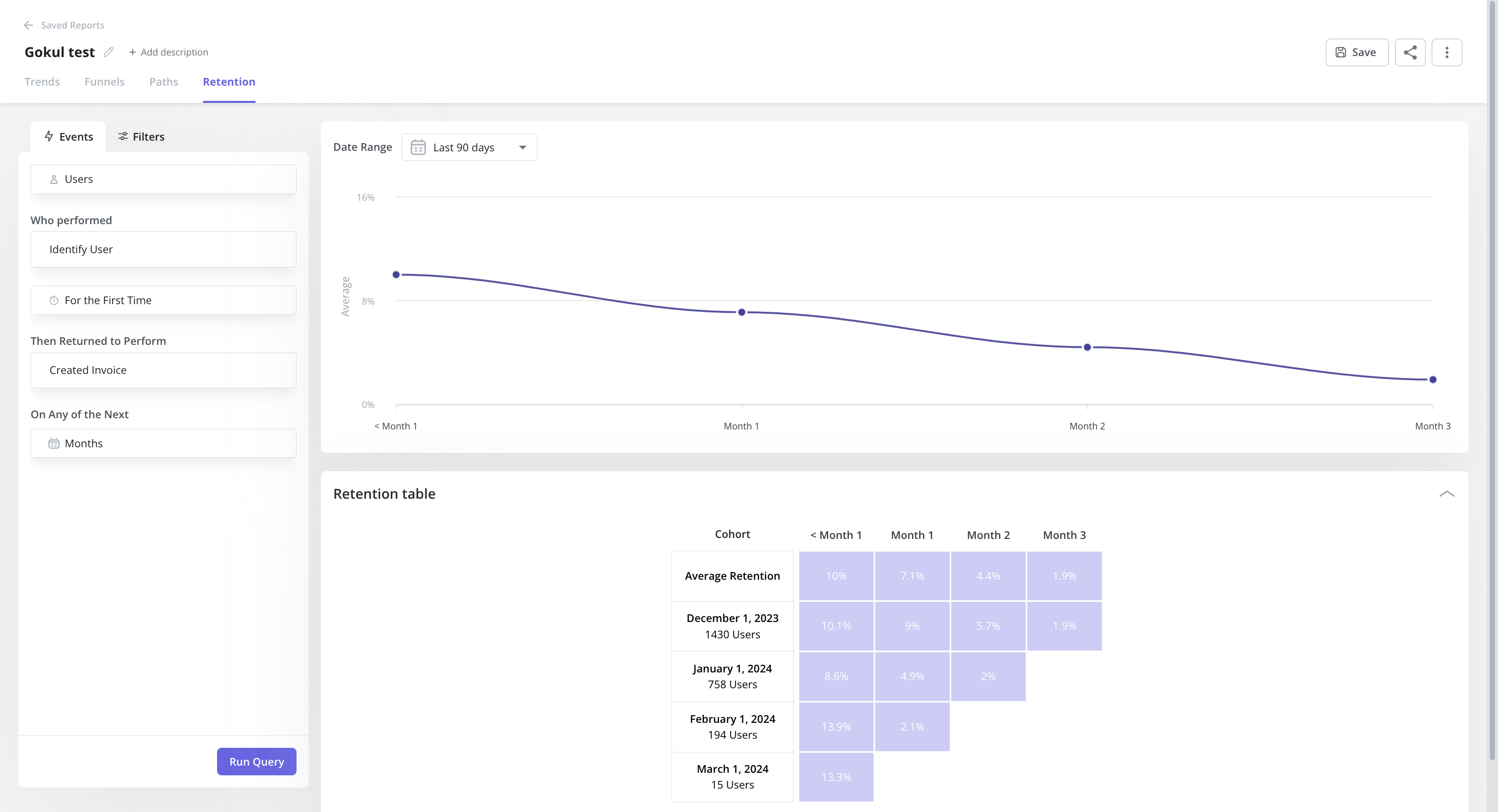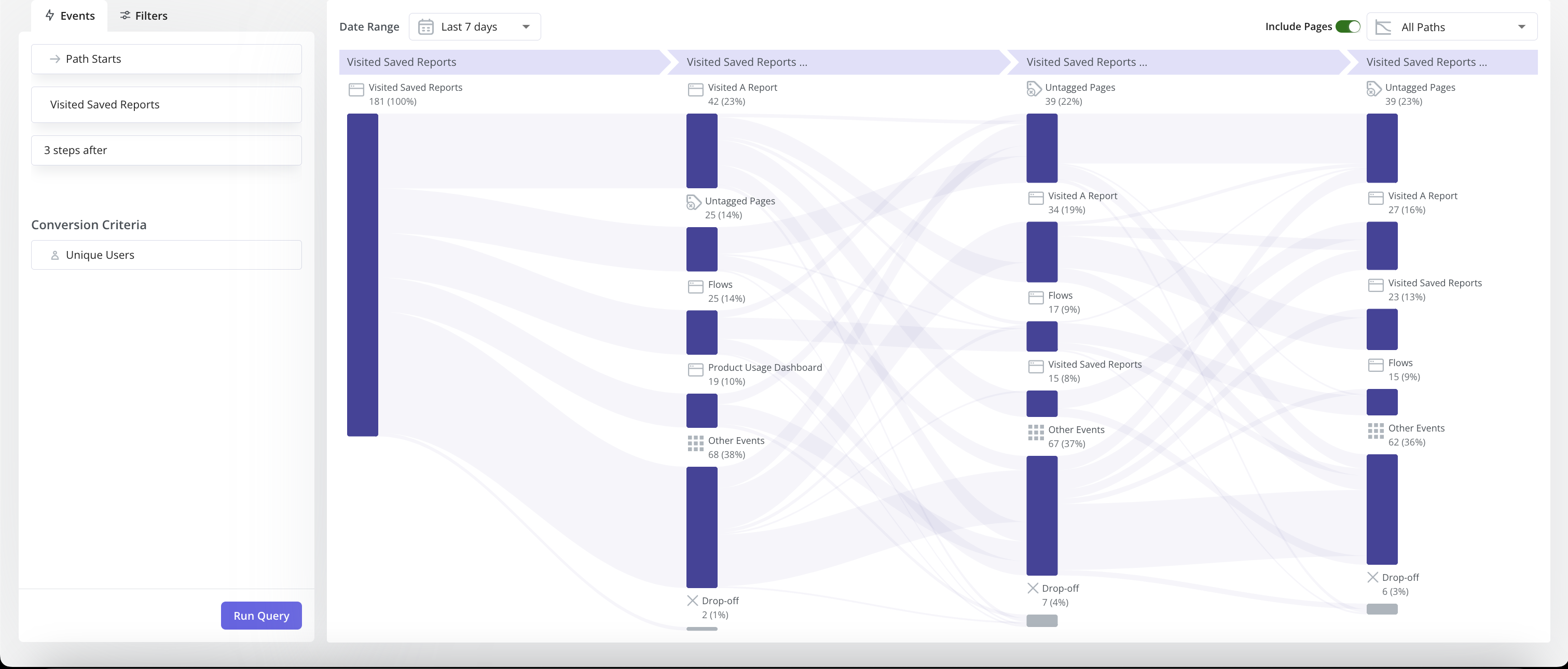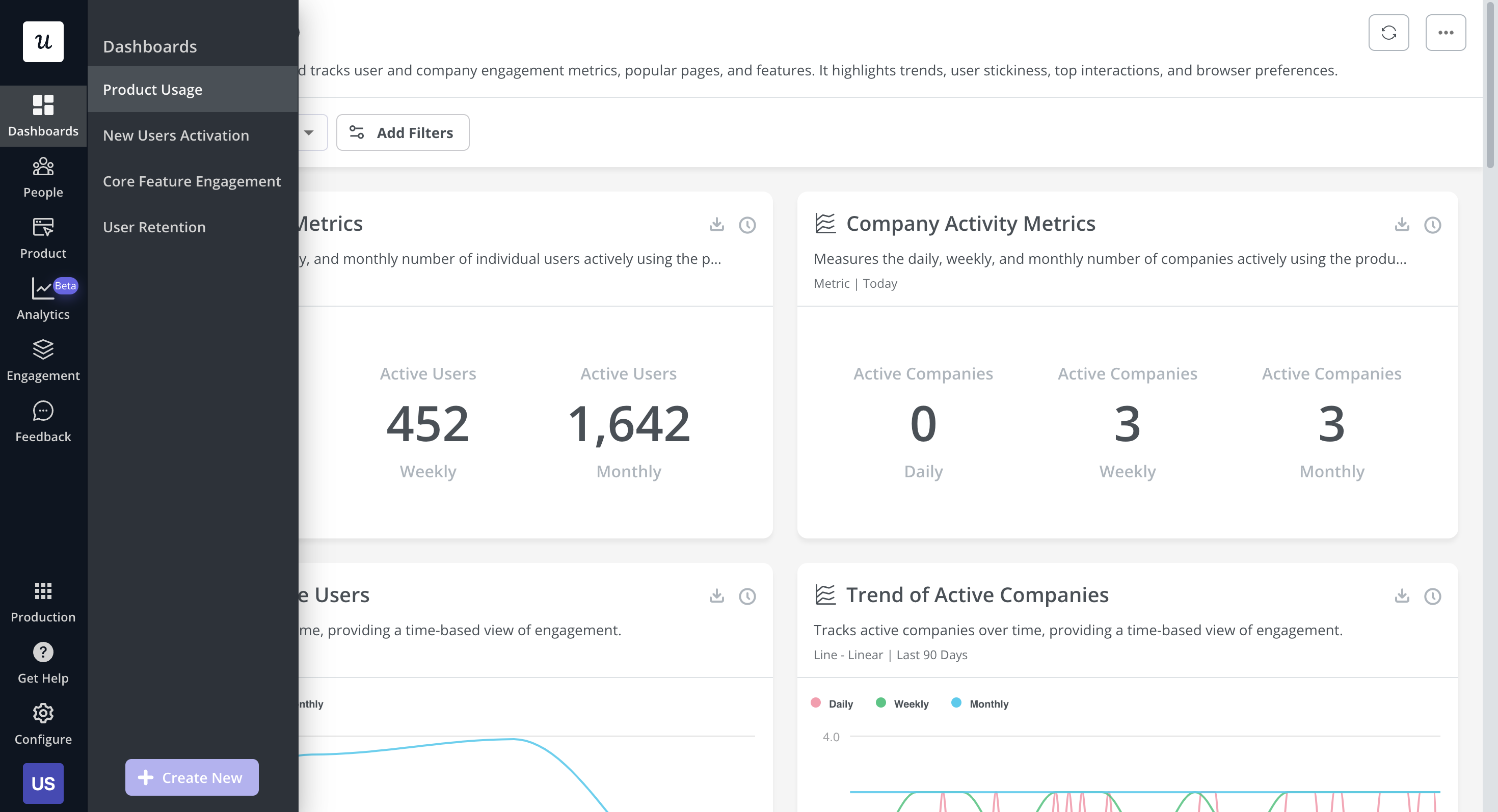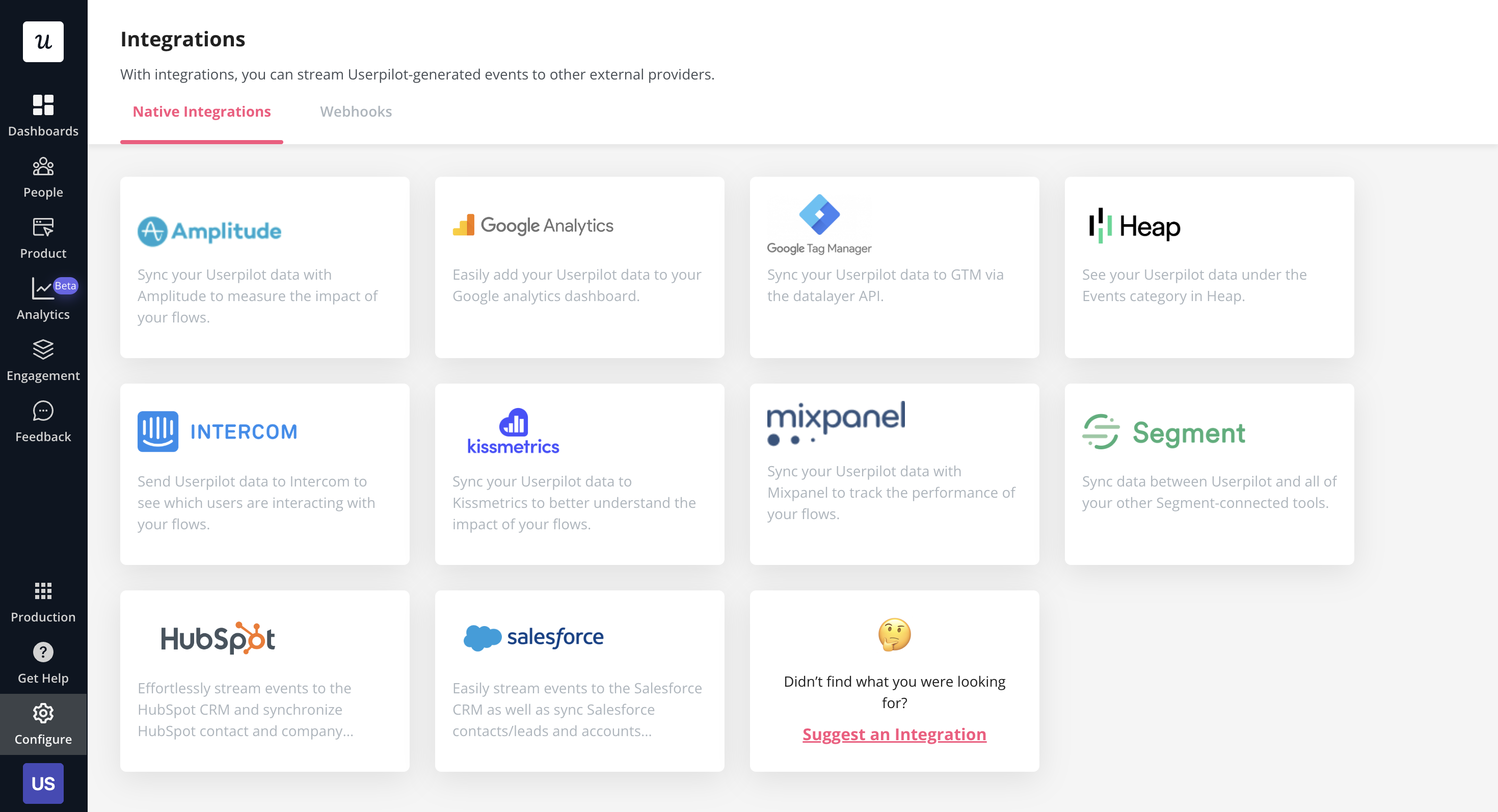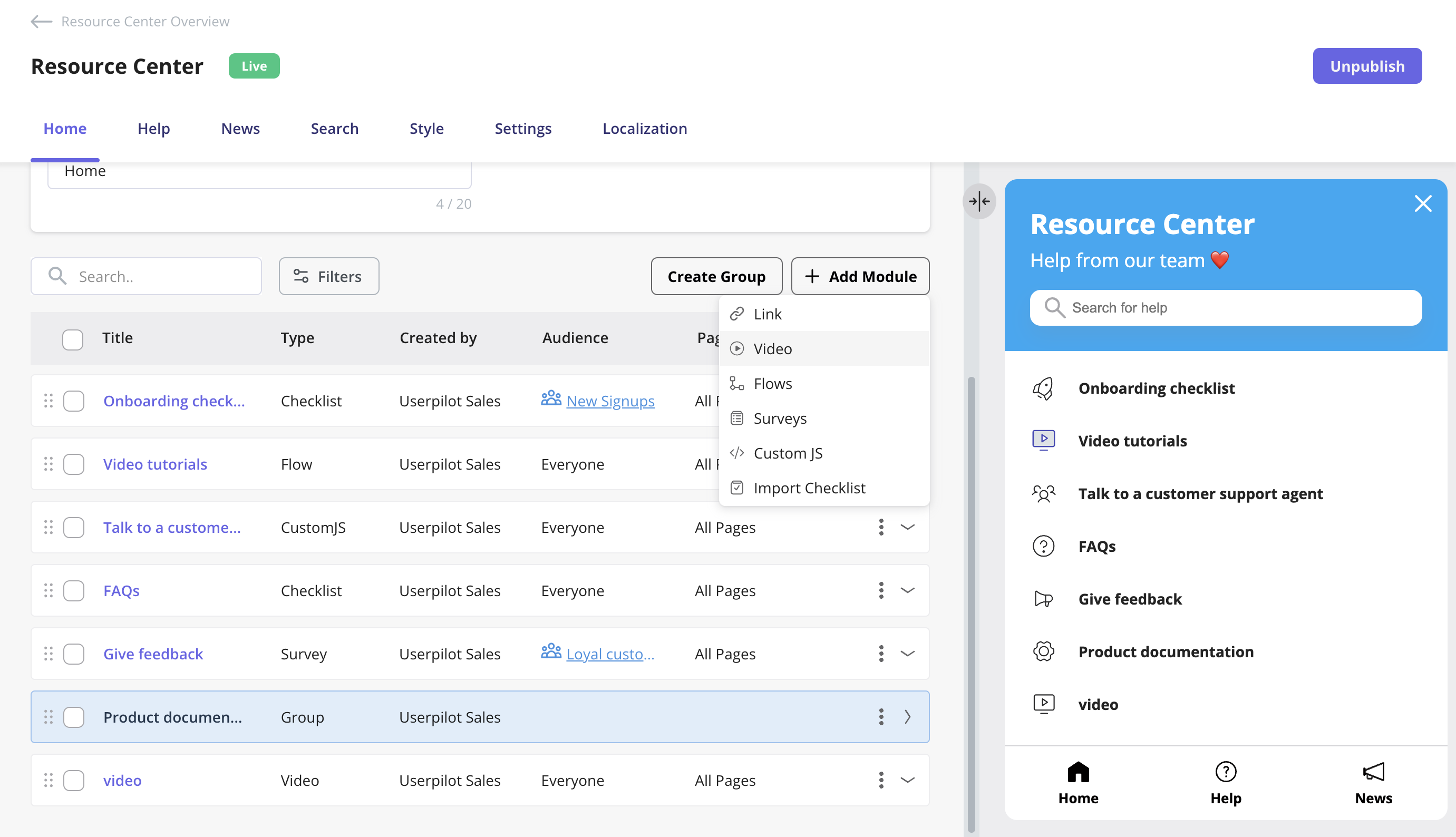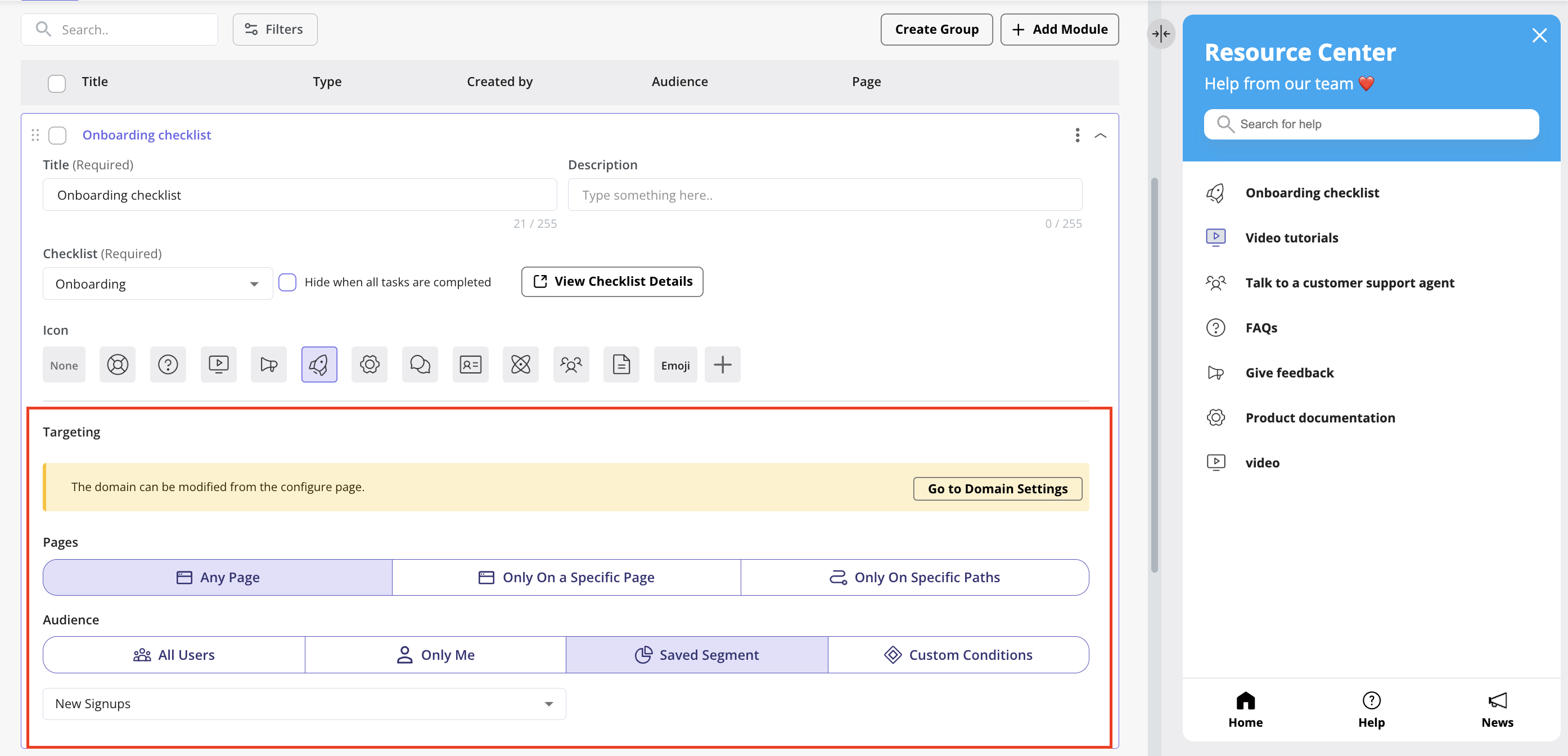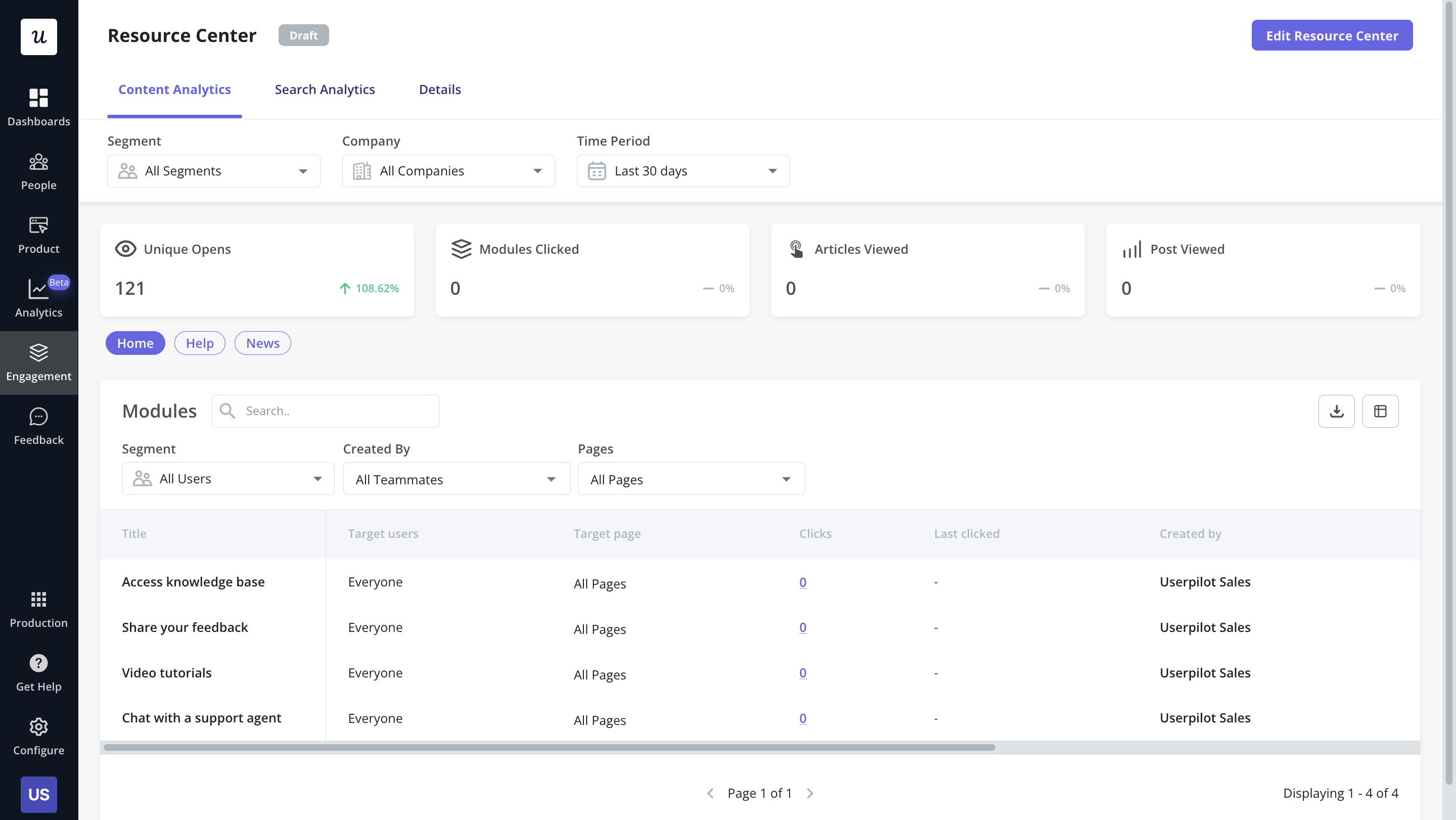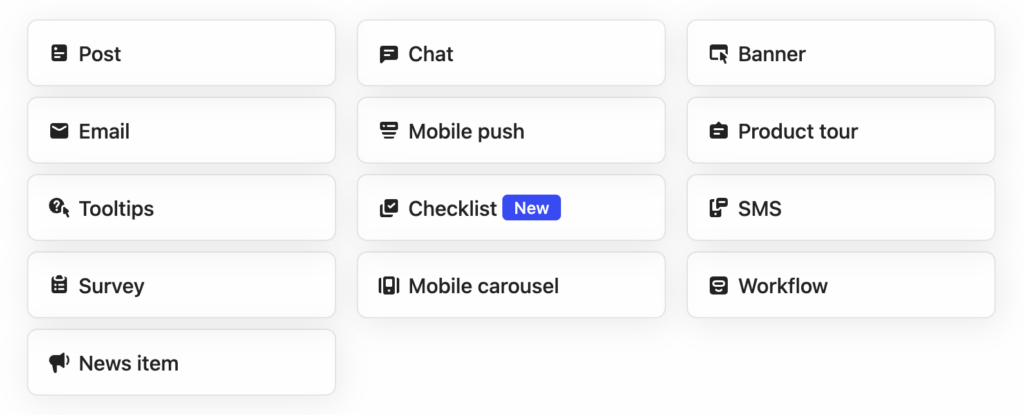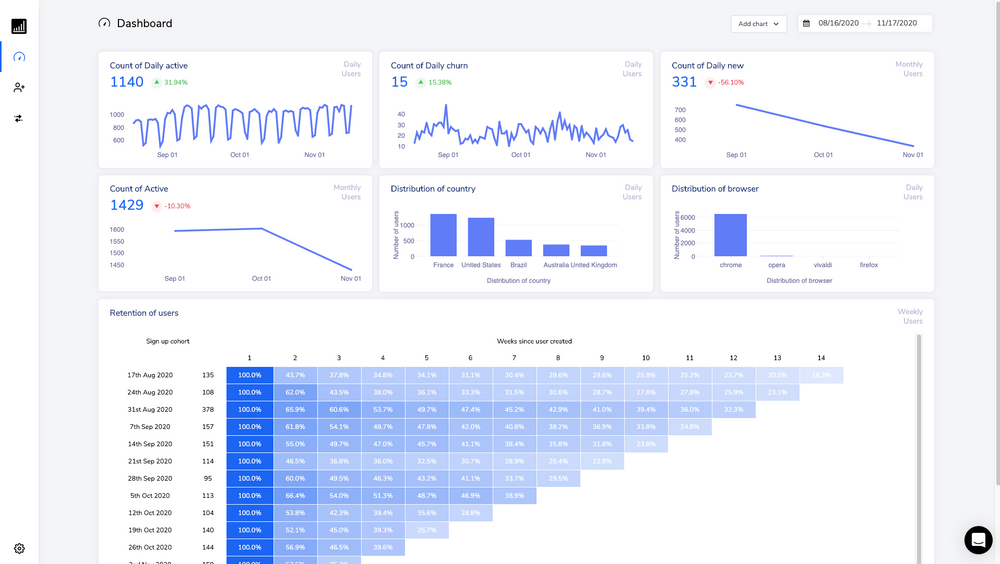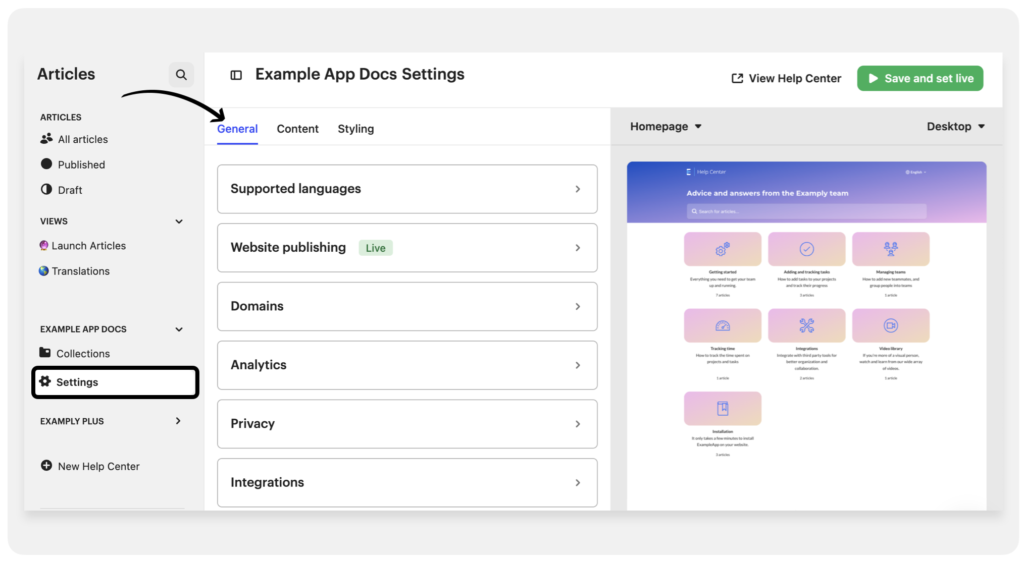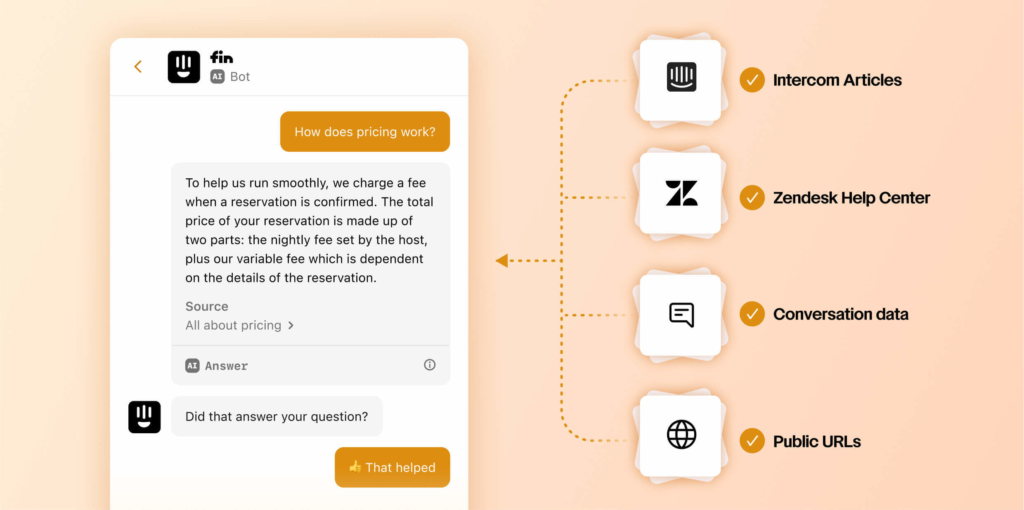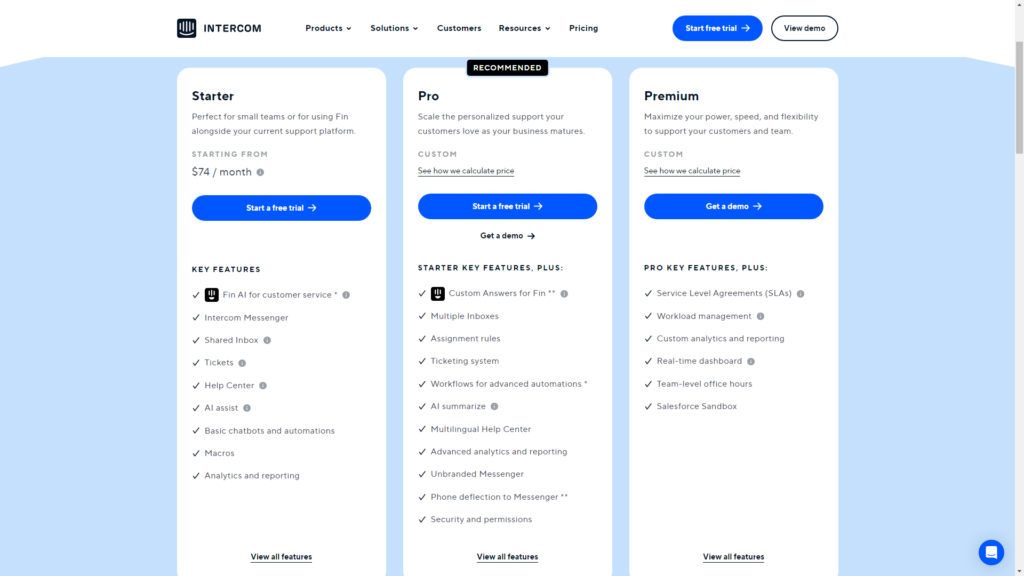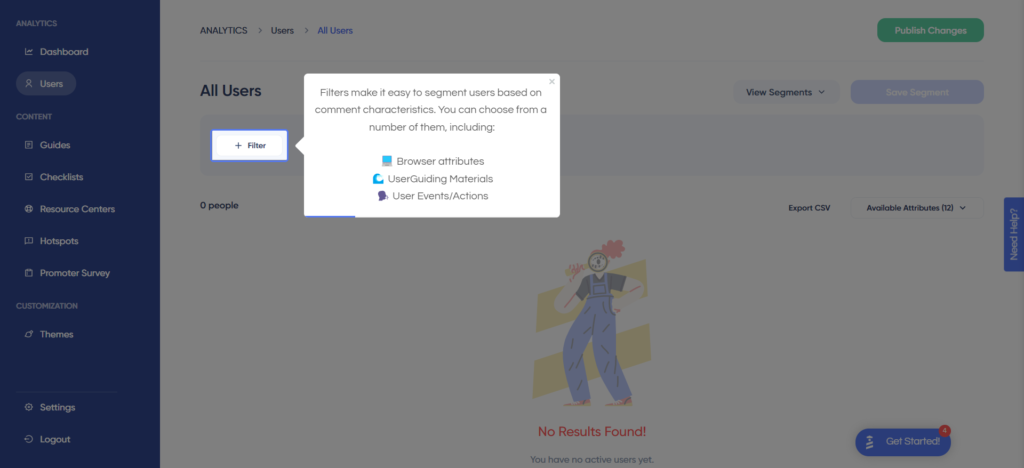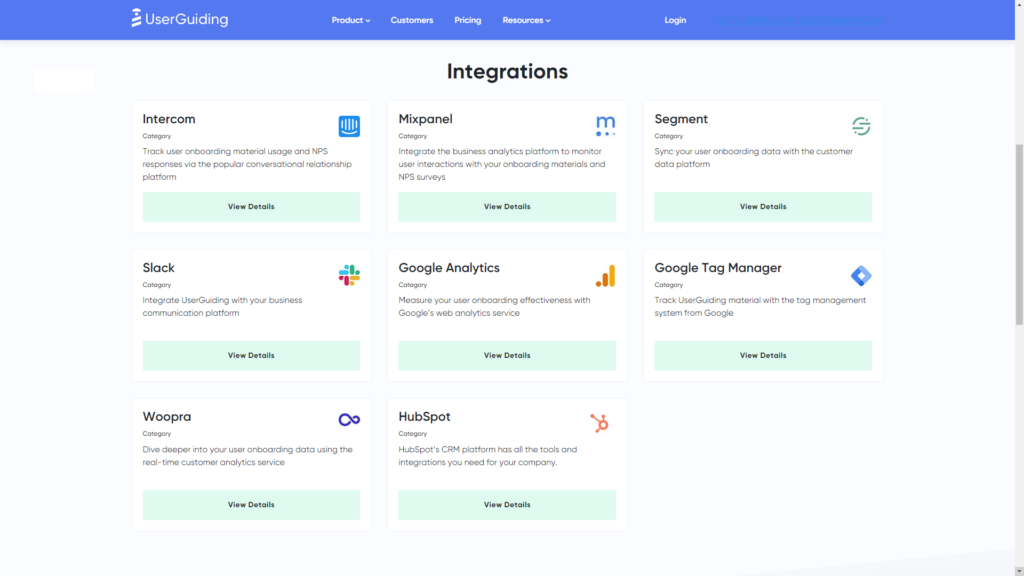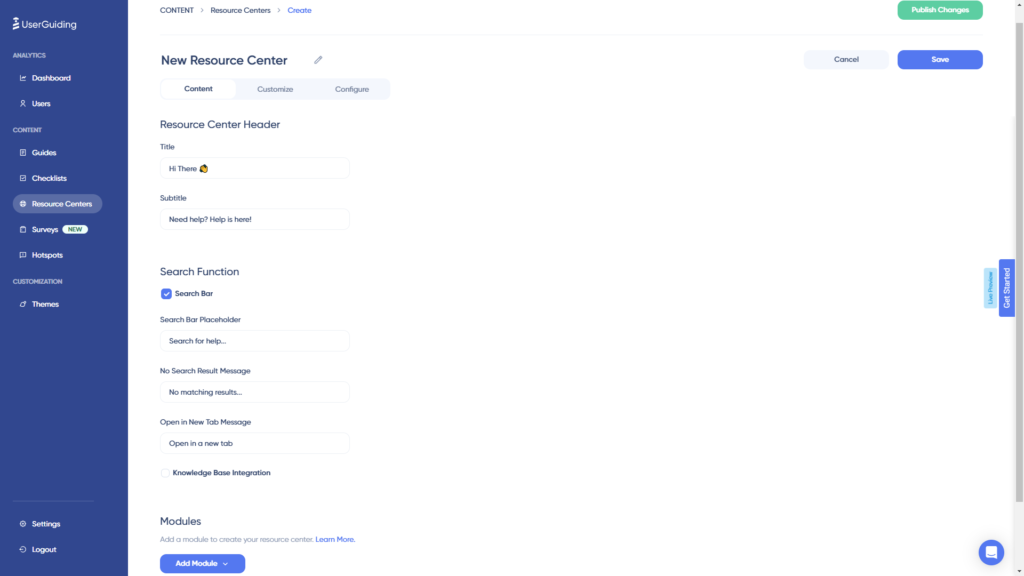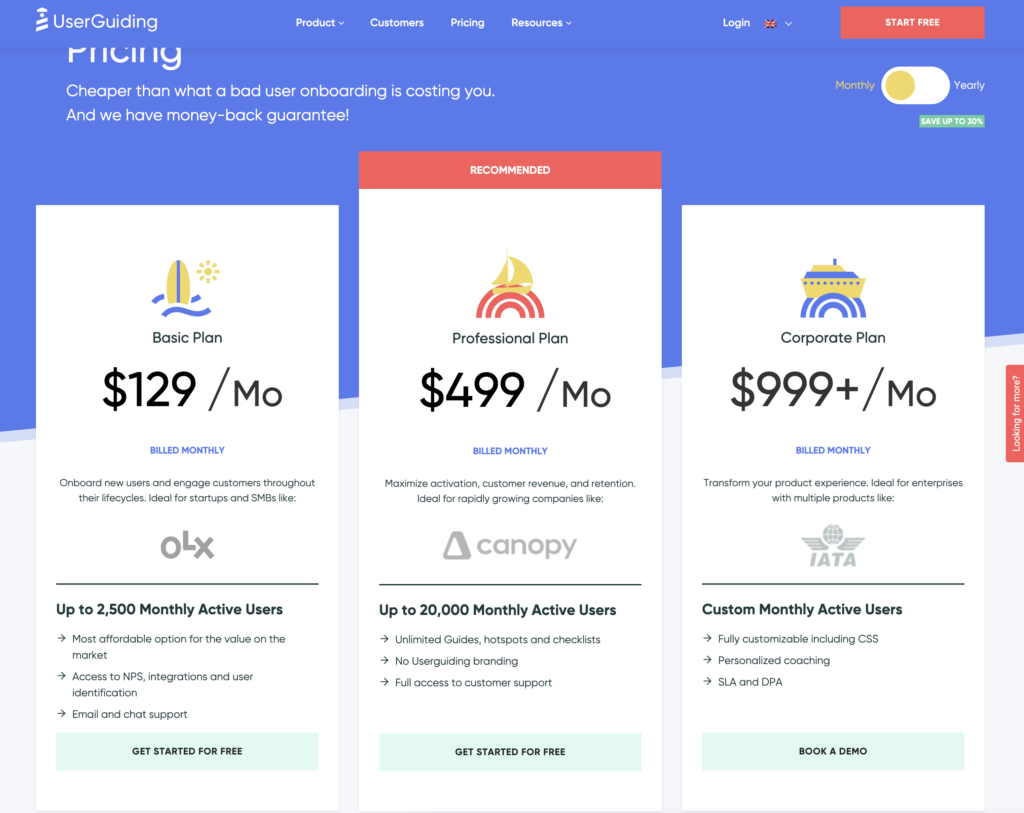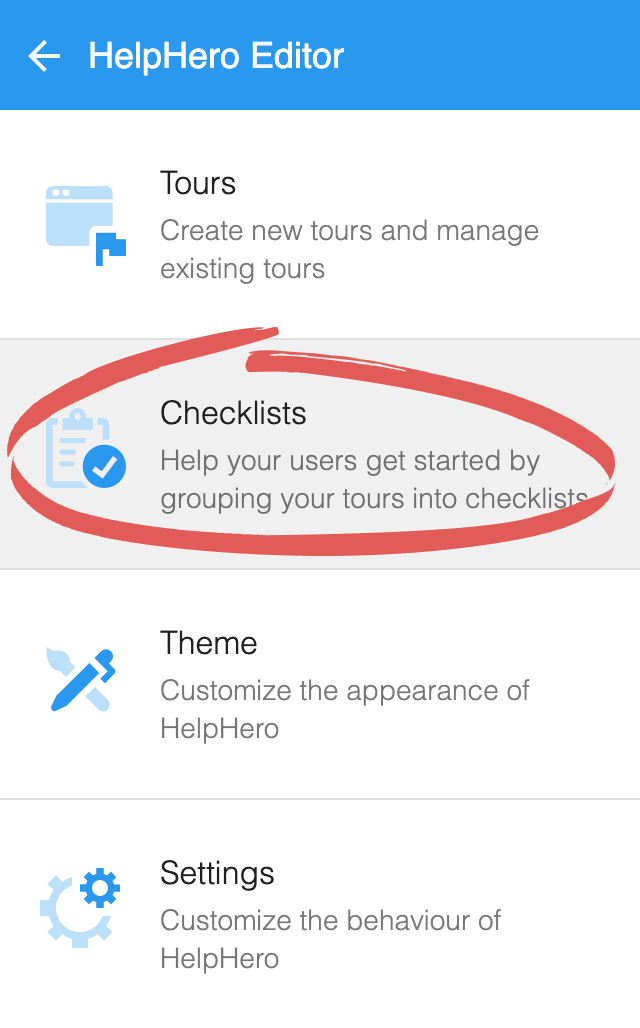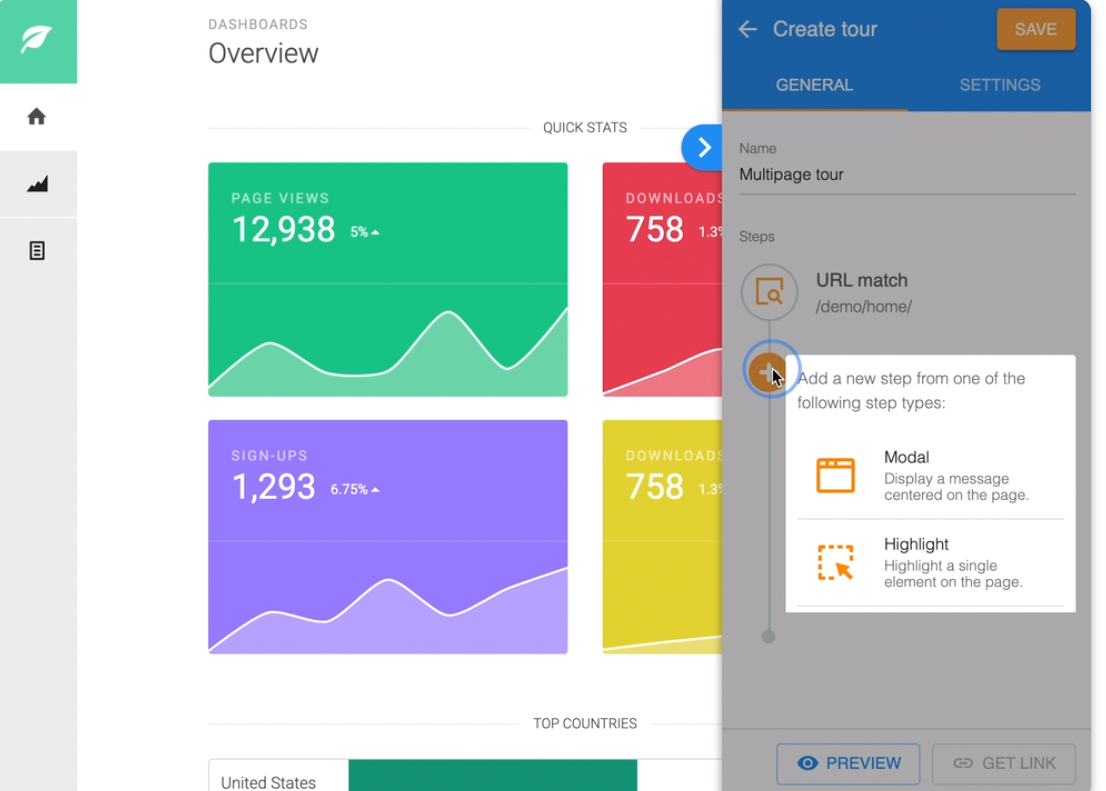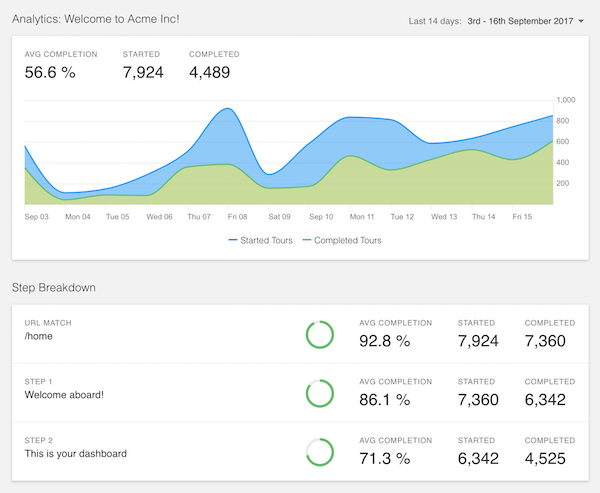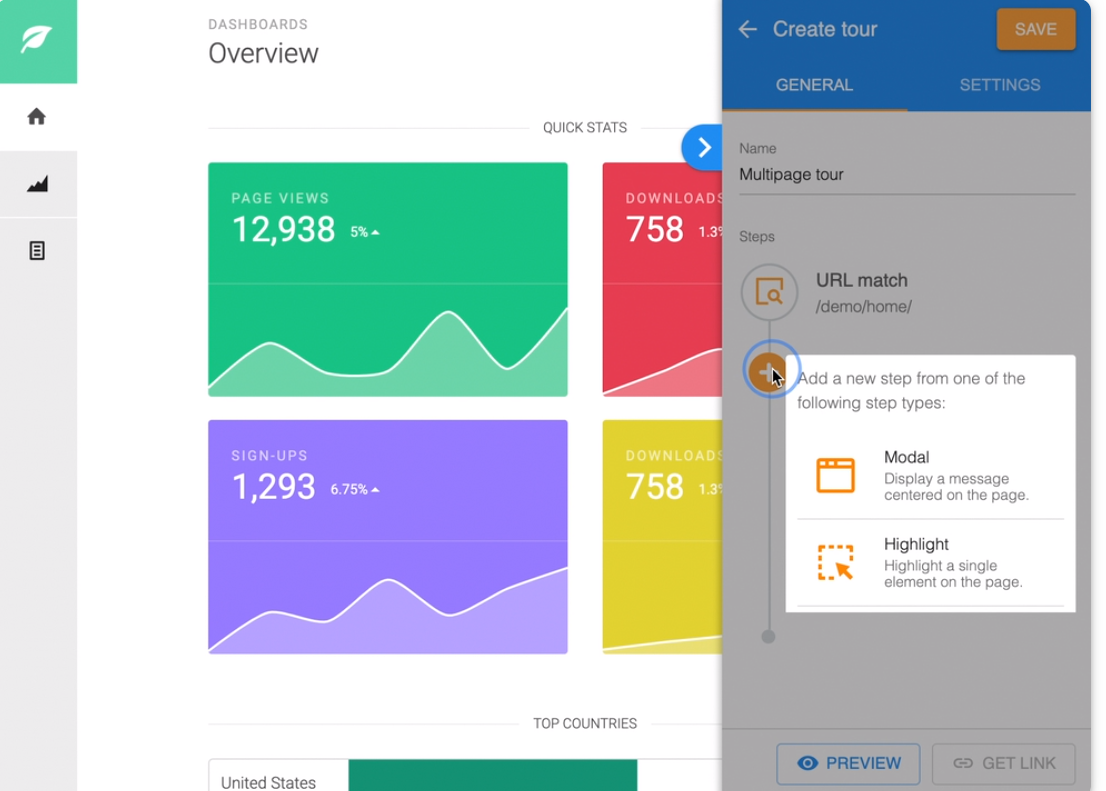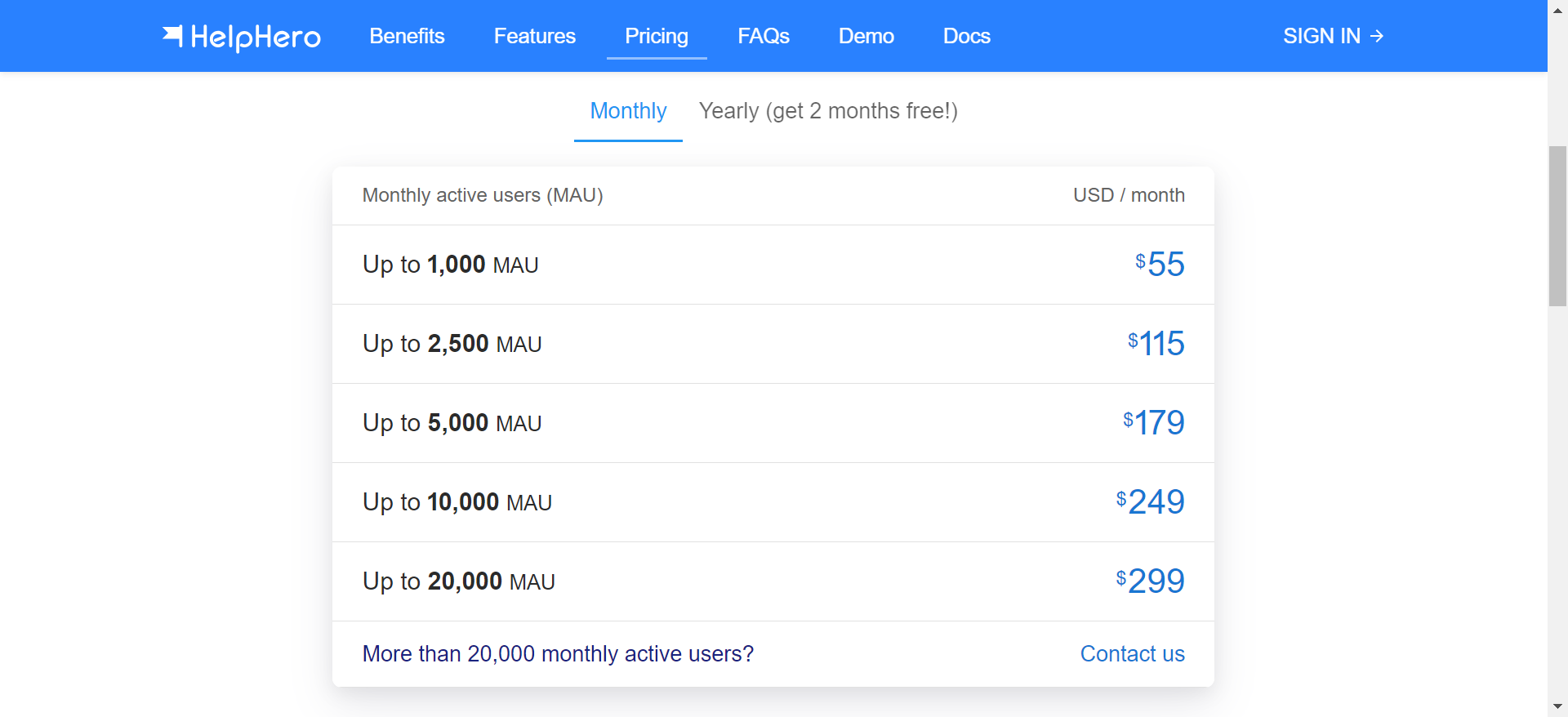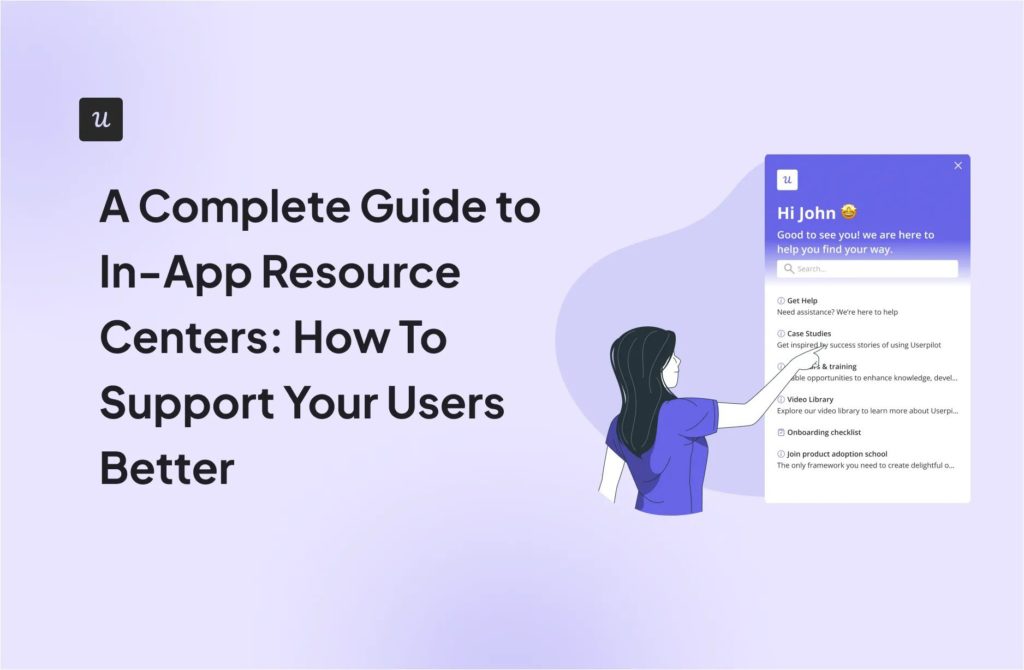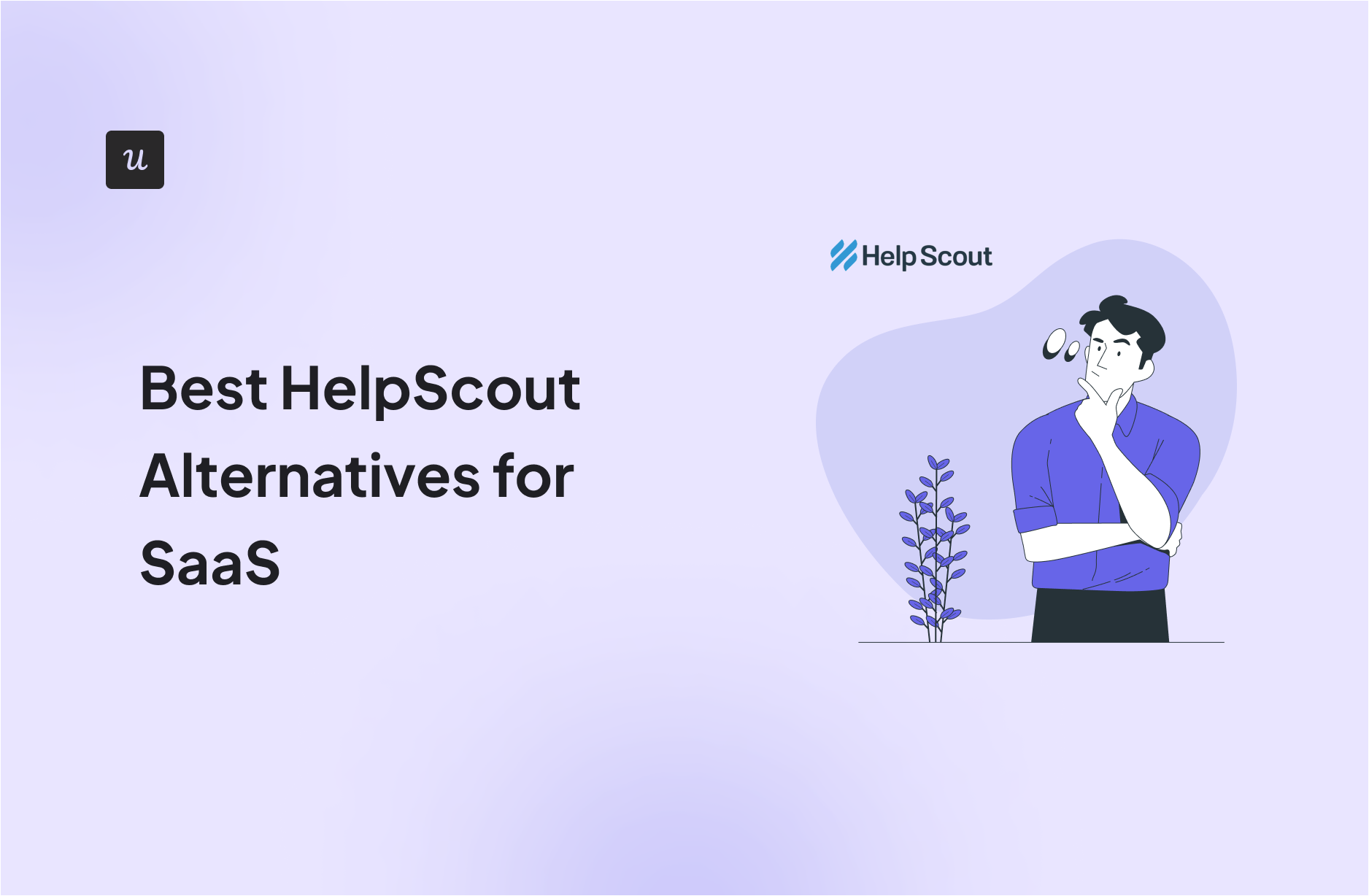
Best HelpScout Alternatives for SaaS28 min read
Get The Insights!
The fastest way to learn about Product Growth, Management & Trends.
What is Help Scout?
Help Scout is a help desk software solution designed to help businesses provide seamless customer support. The platform offers a broad spectrum of features, including shared inbox, live chat, and knowledge base, to manage and organize customer support interactions.
Help Scout lets you assign customer conversations to specific team members and resolve urgent requests on priority. You can even set up workflows to automate routine tasks and speed up response times.
Additionally, the live chat feature lets you communicate with customers in real time and provide immediate assistance. You also have the option to collect user feedback through microsurveys and NPS (Net Promoter Score) surveys.
What are the main use cases for Help Scout?
Understanding the core functionalities and use cases of Help Scout is crucial for deciding whether or not it’s the right choice for you.
Without further ado, let’s see the primary scenarios where Help Scout is useful for your SaaS business!
Help Scout for user onboarding
A frictionless onboarding experience plays a crucial role in converting free trial users to paid ones. It can also help drive feature adoption and user retention.
Unlike Userpilot, Help Scout doesn’t offer tools to design targeted product tours or walkthroughs to handhold new users. Nevertheless, it comes with a few features that can support your onboarding efforts. These include:
- The Beacon tool lets you provide contextual support to new users. You can create a Beacon to recommend relevant knowledge base articles or encourage them to reach out to you via the live chat option. Additionally, you can customize the Beacon’s appearance to match your product’s branding.
Beacon tool. - If you’ve created a Beacon, you can use the Messages feature that lets you gently nudge users to check out product tours or setup guides. You can even send them important announcements regarding new features or upcoming outages. Timely updates can be crucial to minimizing friction in the user journey.
Messages in Beacon. - The Docs features lets you build a robust knowledge base. You can create articles addressing common user queries or provide step-by-step instructions for different tools. You can even organize articles into different categories, making it easier for users to find relevant content.
Creating a knowledge base.
Help Scout for product analytics
Help Scout’s analytics and reporting features are restricted to customer support performance insights. The platform doesn’t offer any tools to track custom events or set up conversion funnels. That makes it difficult to assess metrics related to product adoption and growth. A dedicated digital adoption platform like Userpilot would be a better fit for product analytics.
Help Scout for self-service support
Whether you want to improve product activation or minimize churn rates, delivering a seamless user experience is non-negotiable. Self-service support plays a crucial role in this regard. It gives users the confidence to navigate your product and get the hang of different features.
Also, it minimizes the volume of support tickets and lets your customer service team focus on more pressing issues.
Here’s how you can implement self-service support with Help Scout:
- The Docs feature lets you build an extensive collection of knowledge-base articles. It can serve as a robust in-app resource center. You can group these articles into different categories, making it easier for users to find the information they need.
- However, keep in mind that you’ll have to create a separate file for each article and upload it to Help Scout. The platform doesn’t offer a built-in WYSIWYG editor to write, edit, and format text. If you’re looking for such a feature, Userpilot would be a better fit.
- Next, you can use the Beacon feature to recommend help center content to users. You can even send personalized recommendations based on where they are within your product or what actions they’ve taken on a page.
- With the Beacon tool, you can also recommend other in-app experiences, such as product tours and onboarding checklists, to users. For instance, you can nudge first-time visitors to check out a welcome tour of your product.
- Additionally, you can give users the option to contact customer support via live chat or email through a Beacon. It helps users seek assistance and troubleshoot problems in real time, which, in turn, minimizes friction.
What are the pros and cons of Help Scout?
Pros of Help Scout?
Help Scout’s robust suite of features is designed to facilitate hassle-free and proactive communication with customers. It’s an excellent option when you’re looking to delight users with self-service resources and in-app support.
Key benefits of Help Scout include:
- Easy-to-use interface: Help Scout offers an intuitive and user-friendly platform to streamline customer interactions. You don’t need a ton of technical knowledge to get it up and running.
- Omnichannel support: With Help Scout, you can organize customer conversations from multiple channels, including email, social media platforms, and live chat. It serves as a central location to monitor and resolve user queries and eliminates the trouble of replying to messages on different platforms.
- Hassle-free integrations: With 50+ third-party integrations, Help Scout can fit into your existing tech stack like a glove. The platform is compatible with a wide array of popular tools, including HubSpot, Shopify, Slack, Salesforce, Mailchimp, Facebook Messenger, and more.
- Cost-effective pricing: Help Scout offers affordable plans starting at just $20 per user per month (billed annually). That makes it suitable for businesses with limited budgets.
- Mobile apps: Help Scout offers mobile apps for both Android and iOS devices. That makes it easy for your team members to check and reply to user queries, even if they’re on the move. It helps cut down response times and improves the overall customer experience.
Cons of Help Scout?
While Help Scout is known for its powerful feature set and user-friendly interface, the platform has its drawbacks. These include:
- Lack of user onboarding tools: Help Scout does an excellent job of helping businesses monitor and manage customer communication. However, beyond that, it offers limited capabilities to facilitate user onboarding and product adoption. You don’t get the option to create and implement personalized in-app product tours.
- Limited user feedback options: Help Scout’s user feedback collection capabilities are restricted to microsurveys and NPS surveys. If you’re looking to collect more detailed feedback or trigger in-app experiences based on survey responses, the platform won’t meet your needs.
- Basic analytics and reporting: Help Scout provides an overview of the performance of customer support executives, including response times and happiness scores. However, it doesn’t offer in-depth insight into in-app user behavior and engagement like Userpilot does. Also, exporting and sharing reports can be cumbersome.
- Lack of ticketing features: Unlike other help desk solutions, Help Scout doesn’t offer an in-built ticketing system.
What do users say about Help Scout?
Help Scout boasts a rating of 4.4 stars (out of 5) on G2 and 4.6 stars (out of 5) on Capterra. Most users praise the platform’s intuitiveness, simplicity, and extensive integrations.
Here’s what a happy user had to say about Help Scout:
“So easy to use, absolutely love it”
the team at Help Scout obviously spoke to customer service agents to understand how they work and what they need to make work easier. the layout is intuitive (much better compared to traditional enterprise solutions) and allows all the most important app integrations
– Stephanie C. (Small business)
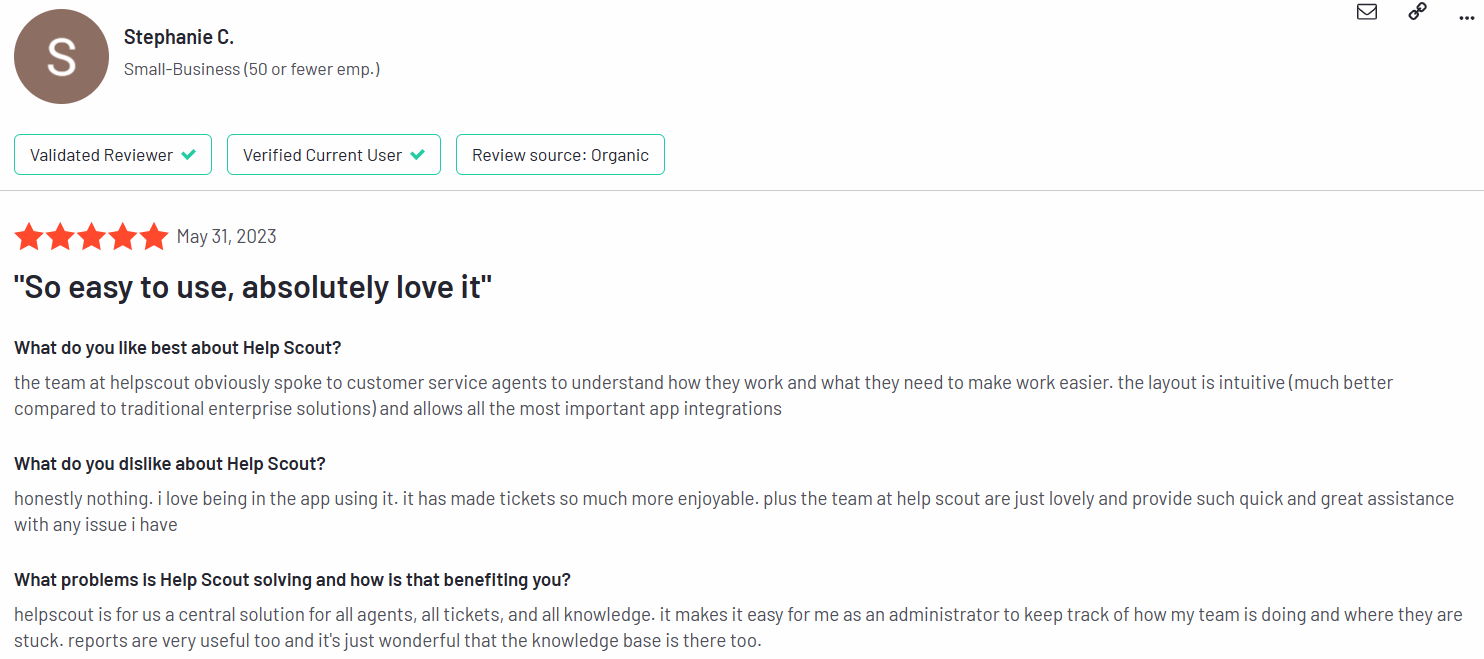
Despite stellar user ratings and reviews, Help Scout isn’t perfect. Some users complain about the complicated process of formatting knowledge base articles to make them look polished and the lack of more template options. Others remark on how many of the integrations are only available in higher plans.
Here’s what a user had to say:
“Don’t think it’s fair”
Help Scout recently announced a new integration with Messenger, which is great news for their users. However, I find it disappointing that this integration is only available for their Pro and Plus plans. In a market where most ticketing and support services offer real-time chat with customers across all plans, it feels unfair to limit such a useful feature to the most expensive tiers.
As a customer, I believe that access to real-time chat should be a basic requirement for any support service. It’s frustrating to see that Help Scout is putting such a critical feature behind a paywall, and it makes me question their commitment to customer satisfaction.
While Help Scout may still be a reliable choice for some businesses, I hope they will reconsider their pricing model and make this integration available to all users. Until then, I will be exploring other options that offer better value for my money.
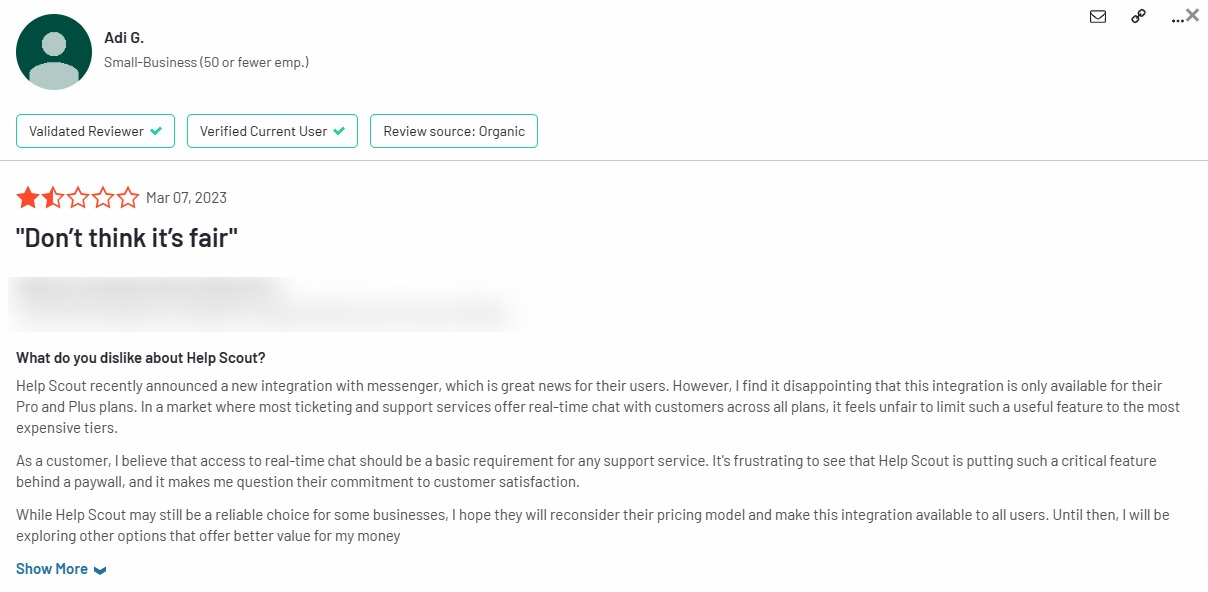
Does Help Scout fit your budget?
Help Scout offers three different pricing plans, with the total cost based on the number of users.
The plans include:
- Standard: It starts at $20 per user per month (billed annually) or $25 per user per month (billed monthly). It includes 2 shared inboxes and 1 Docs knowledge base. Also, you’ll have to pay extra for in-app messaging if the total number of viewers exceeds 2000.
- Plus: It starts at $40 per user per month (billed annually) or $50 per user per month (billed monthly). It includes everything in the Standard plan, along with advanced analytics, custom reporting, AI features, and integration with popular apps like Salesforce and HubSpot.
- Pro: It starts at $65 per user per month and only offers an annual subscription. It includes everything in the Plus plan, along with concierge onboarding services, a dedicated account manager, and enterprise-level security and compliance.
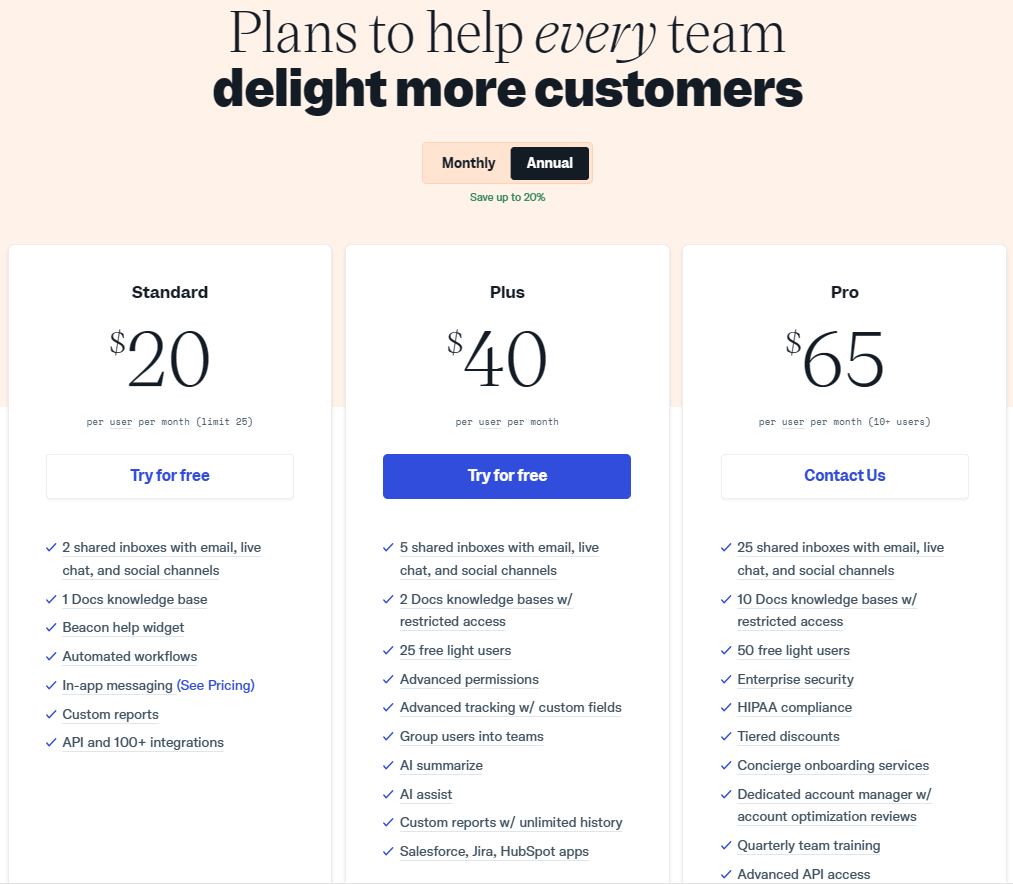
While the Standard plan is suitable for small teams with limited budgets, the Pro plan is a good fit for large businesses. However, keep in mind that pricing is based on the number of users, and the costs can quickly escalate as your team grows.
Help Scout offers a 15-day free trial that allows you to test various features and tools and determine whether it’s the right fit for your needs.
3 Reasons why you might need a Help Scout alternative
Help Scout offers a powerful suite of features to help businesses streamline customer support interactions and provide timely assistance. However, it may not be the right fit for everyone.
Here are three scenarios where it makes sense to consider a Help Scout alternative:
- You need a more holistic product adoption platform: Customer communication is an integral part of product adoption, but it isn’t everything. If you want features that let you create targeted in-app flows and control the user journey, a platform like Userpilot might be a better fit than Help Scout.
- You want to collect detailed user feedback: Help Scout’s user feedback options include microsurveys and NPS surveys. It may not be enough when you’re looking to understand user sentiment and identify ways to improve product adoption. In such cases, Userpilot’s extensive survey options can come in handy.
- You want to track user behavior and engagement: Help Scout’s analytics dashboard offers a basic overview of customer support performance. If you want more granular data on how users move through your product and what drives them away, it’s wiser to consider an alternative.
Better alternatives to Help Scout
Considering alternative options to Help Scout can often lead to discovering more tailored solutions that better suit your needs. Here are the top Help Scout alternatives you can consider:
- Userpilot is a product growth platform that drives user activation, feature adoption, and expansion revenue. It also helps product teams collect user feedback, streamline onboarding, and gather actionable insights from analytics. With Userpilot, you’ll be able to track both product usage and user behavior to get a holistic view of how customers use your product — which will guide future development, improve the user experience, and inform your growth efforts.
- Intercom is a customer service platform. It offers customizable live chat widgets, omnichannel support capabilities, and integrations with over 300 apps. While Intercom is primarily a support solution, it does have add-ons that offer other functionalities such as product tours. The Product Tours add-on contains features that aid onboarding, adoption, and feature discovery. Intercom’s product tours can include UI patterns like modals and tooltips as well as other media formats such as microvideos.
- UserGuiding is a no-code product adoption tool that lets users create in-app walkthroughs, guides, and checklists. The solution makes it possible for teams to onboard, engage, and retain users without needing coding skills to create these in-app experiences. All in all, UserGuiding is a pretty flexible solution that can improve the onboarding process, boost user engagement, and increase customer retention.
- HelpHero is a tool that enables businesses to build interactive, easy-to-follow product tours that help engage users from day one and speed up feature adoption quicker than ever. In addition, with HelpHero, you can easily create and customize walkthroughs without coding. You can use it to ensure users know what’s new and how to use it. The result – is less frustration and confusion and higher user adoption and retention.
Let’s see the features and functionalities of these tools for different use cases!
Help Scout vs Userpilot
There are many ways how Userpilot is different (and in a lot of ways better!) from Help Scout. Let’s explore the features of Userpilot, how it’s better than Help Scout, and how it may fall short too.
Userpilot for user onboarding
User onboarding is a crucial part of the customer journey as it speeds up the adoption process and increases retention rates. Onboarding is one of Userpilot’s core use cases along with product growth analytics and user feedback, so it has plenty of features that you can utilize.
Here are some Userpilot features you can use when onboarding new users:
- No-code builder: Creating flows with Userpilot is as simple as installing the Chrome extension, selecting the UI patterns you’d like to use, and then editing the content/settings to suit your use case. You can also use templates to create modals, slideouts, tooltips, and driven actions.
No-code flow builder in Userpilot. - Native tooltips: Userpilot lets you create native tooltips that show up when users hover over an element or click on an information badge. Since these native tooltips attach to the element itself, they aren’t page-dependent and will show up on any screen where that element is visible.
Build native tooltips with Userpilot. - Advanced flow settings: With advanced condition settings, you can decide when, where, and who you’ll be triggering your onboarding flows. This helps you create contextual and personalized onboarding experiences that drive engagement and adoption.
- Onboarding engagement analytics: You can easily assess the impact of your onboarding flows, guidance, etc. by analyzing the engagement rate of tooltips, interactive walkthroughs, checklists, etc. In addition, you can also build reports (funnels, paths, etc.) or dashboards to track your core onboarding metrics i.e. activation, stickiness, drop-offs, etc.
Userpilot for product analytics
Product analytics lets you collect and analyze data about how users interact with your product so you can extract actionable insights. Userpilot lets you look at granular product analytics, such as which features have the highest adoption rates, and big-picture insights like trend reports. Here are Userpilot’s top product analytics features:
- Feature tagging: Userpilot’s click-to-track feature tagger lets you view how many times a feature has been used and by how many users to measure its adoption. Users on the Starter plan can add up to 10 feature tags while those on the Growth or Enterprise tier can create unlimited tags.
No-code feature tags in Userpilot. - Event-tracking: Alongside no-code feature tags for feature engagement tracking, you can also track other events unique to your product using event-tracking. You can also create a group of events to track a specific process i.e. onboarding, subscription, etc.
Create tracked events to monitor server-side data. - Trends and funnels: Userpilot’s trends and funnels report lets you extract actionable insights from big data. You’ll be able to see which stage of an onboarding/conversion funnel most users drop out on and create trend reports with detailed breakdowns by user or period.
Example of a trend report in Userpilot. - Retention tables: This lets you gauge product performance – how effective it is at retaining users using cohort tables and retention curves.
- Paths: You can generate and access path reports directly within the reporting builder in Userpilot, alongside funnels, trends, and retention reports. With Paths, you can have an overview of how users navigate your product features – offering invaluable insights into their interactions with your products.
- User & Company profiles: Here you can view data related to a certain user/company to gain insights into their behavior and improve the overall user tracking experience. This helps you understand how they engage with your product or platform, better identification of areas of improvement, and tailor their offerings more effectively.
User profile with top event data that provides insights into what feature they regularly engage with. - Analytics dashboards (Product Usage, New Users Activation, Core Feature Engagement, User Retention, etc.): These dashboards enable you to keep track of your key product performance and user behavior metrics at a glance, without any technical setup required.
- Analytics integrations: Userpilot integrates with some of the most popular analytics tools like Amplitude, Mixpanel, Segment, Google Analytics, and more. This makes it possible to sync product analytics both ways between the tools in your tech stack (two-way integration is only available for Hubspot at the time of writing, more to come).
Userpilot for self service support
Here’s how you can use Userpilot to create a self-service customer experience:
- No-code builder: Userpilot’s no-code resource center lets you add modules without writing a single line of code. Module options include links, videos, flows, custom JavaScript functions, and checklists. You can also group modules into sections to help users navigate the resource center.
Add different types of content to your resource center. - Module segmentation: Userpilot’s segmentation settings let you hide or show specific modules within your resource center based on audience settings. This makes it possible to create modules for different user segments and hide resources that aren’t relevant to other users.
Help module visibility condition settings. - Resource center analytics dashboard: The dedicated analytics dashboard helps you see how many unique visitors your resource center gets, how many modules have been clicked, the overall click rate across your user base, and popular search terms. This will make it easier to gauge resource center performance and identify if anything is missing from your resource center.
Resource center content analytics in Userpilot.
Pricing of Userpilot
Userpilot’s transparent pricing ranges from $249/month on the entry-level end to an Enterprise tier for larger companies.
Furthermore, Userpilot’s entry-level plan includes access to all UI patterns and should include everything that most mid-market SaaS businesses need to get started.
Userpilot has three paid plans to choose from:
- Starter: The entry-level Starter plan starts at $249/month and includes features like segmentation, product analytics, reporting, user engagement, NPS feedback, and customization.
- Growth: The Growth plan starts at $749/month and includes features like resource centers, advanced event-based triggers, unlimited feature tagging, AI-powered content localization, EU hosting options, and a dedicated customer success manager.
- Enterprise: The Enterprise plan uses custom pricing and includes all the features from Starter + Growth plus custom roles/permissions, access to premium integrations, priority support, custom contract, SLA, SAML SSO, activity logs, security audit, and compliance (SOC 2/GDPR).
Help Scout vs Intercom
There are many ways how Intercom is different (and in a lot of ways better!) from Help Scout. Let’s explore the features of Intercom, how it’s better than Help Scout, and how it may fall short too.
Intercom for user onboarding
User onboarding educates new customers, teaches them how to use your product, and helps them get the most value in the least amount of time.
Intercom’s Product Tours add-on includes UI patterns and onboarding analytics that can prove helpful (if you’re willing to pay extra for them).
This will cost you an additional $199/month on top of what you’re currently paying for your base Intercom subscription. This puts its pricing on par with dedicated onboarding/adoption tools despite lacking feature parity.
Here’s an overview of Intercom’s Product Tours add-on:
- UI Patterns: Intercom’s product tours for onboarding come with an expansive selection of UI patterns like tooltips, banners, surveys, in-app checklists, and multi-step flows. You can also use communication features in your tours such as SMS messages or live chat widgets.
- Onboarding Analytics: Intercom shows you detailed analytics for each product tour such as the total number of views, overall completion rate, percentage of users who achieved a particular goal, and how many issues were encountered during the tour.
Intercom for product analytics
Product analytics track all data related to using the product itself so you can get a better understanding of user behavior and identify areas for improvement.
Intercom helps you monitor analytics with third-party integrations and subscription add-ons.
- Integrations: The Intercom App Store has integrations with over 300 third-party tools. These include dedicated analytics solutions like Amplitude, Heap, Databox, Google Analytics, and CRM platforms like Salesforce or HubSpot.
- Analytics (Add-On): The Analytics for Intercom add-on expands its reporting capabilities to include a segment explorer, user attributes, and retention analysis. The analytics add-on costs an additional $50/month to $200/month (on top of your current plan), depending on the tier.
Intercom for self service support
Self-service support helps users solve their own problems so they get faster resolution times without needing to take up the time of your support representatives. Intercom has self-service support features like a help center, chatbot, and third-party knowledge base integrations.
Here’s how you can use Intercom to create a self-service customer experience:
- Help Center: The Intercom help center lets you publish resources in multiple languages, host them on a custom domain, and embed third-party apps if needed. Any help articles published here will also be used to feed information to your support chatbots down the line.
Note: Intercom’s multilingual help centers are only available on the Pro tier and higher which means users on the entry-level Starter plan ($74/month) won’t be able to use this feature. Help articles aren’t automatically translated so you’ll need to rewrite them manually as well.
- Fin Chatbot: The Fin chatbot is built on GPT-4 which allows it to respond naturally while drawing data from multiple sources. It can reference articles in your help center, look at conversation data, search through public URLs, or pull information from integrations.
- Third-Party Integrations: Intercom has integrations for external knowledge base solutions. There are over 20 knowledge base tools that Intercom can integrate with to import articles, videos, and other support data. This includes Zendesk, Freshdesk, HelpDocs, and more if you are on the Pro plan (the Starter plan drastically restricts available integrations).
Pricing of Intercom
Intercom’s plans start at $74/month on the entry-level plan and use custom pricing for the Pro tier or higher. There’s no free version available, but Intercom does offer a 14-day free trial that lets you test all features on the Starter tier before upgrading to a paid subscription.
Intercom has three paid plans to choose from and different add-ons priced separately:
- Starter: Starts at $74/month and includes two team seats, and features like the messenger widget, automated chatbots, shared inbox, real-time tickets, help center, macros, and basic analytics reporting capabilities.
- Pro: Custom pricing based on the number of team seats and MAUs. It includes features like multiple inboxes, assignment rules, ticketing systems, localized help centers, and advanced automation/analytics.
- Premium: Custom pricing based on the number of team seats and MAUs. It includes features like a real-time dashboard, custom analytics, workload management, and a service level agreement.
In addition to the base subscription cost, you’ll need to pay an additional $199/month if you want to use the Product Tours add-on. This means that, even on the Starter plan, you’d still be paying almost $300/month in total if you get the Product Tours add-on to go with it.
Help Scout vs UserGuiding
There are many ways how UserGuiding is different (and in a lot of ways better!) from Help Scout. Let’s explore the features of UserGuiding, how it’s better than Help Scout, and how it may fall short too.
UserGuiding for user onboarding
As a no-code onboarding tool, UserGuiding has numerous features that will help you create onboarding flows for your new customers and guide them throughout their journey.
Here’s what you’ll get when you start using UserGuiding:
- Create interactive product walkthroughs without disturbing your developers as it’s completely code-free.
- Build onboarding checklists and drive customers to the activation point by eliminating the guesswork on what the next step should be.
- Create interactive elements, such as product tours, tooltips, and pop-ups, to help keep users engaged and increase the likelihood that they’ll complete the onboarding process.
- Create a resource center to add different educational resources for your users.
Though UserGuiding is a great tool for startups that don’t have much money to invest in an onboarding tool, it has very strict limitations for the Basic plan.
You can only create a maximum of 20 guides and hotspots, 2 onboarding checklists, and 1 resource center. If you want to create unlimited guides with unlimited UI patterns, you should go for the Professional plan which can cost from $299 to $399.
The one drawback when using UserGuiding for onboarding is the fact that its analytics dashboard only encompasses the elements that you’ve created within the platform. In contrast, Userpilot is able to track all elements, events, and behaviors throughout the entire user journey.
UserGuiding for product analytics
Product analytics are a cornerstone of any growth strategy as they offer insights into how existing customers have used the product. They can also highlight similarities between users within certain cohorts (such as power users or churned customers).
Unfortunately, UserGuiding has no native product analytics capabilities. The only data it’s able to collect are interactions with UserGuiding materials such as guides, checklists, hotspots, or resource centers.
It does have integrations with analytics platforms like Amplitude, Mixpanel, Segment, and Woopra. However, the depth and flexibility vary from integration to integration — not to mention the fact that you’ll need to pay extra for a standalone analytics product before you can integrate it.
UserGuiding for self-service support
As an onboarding solution, UserGuiding is targeted toward the initial tours, walkthroughs and flows that new users go through. However, it does have certain customer education features that could be utilized in the context of self-service support:
- Resource Center: The most suitable UserGuiding feature for self-service support is the resource center. Resource centers created with UserGuiding are also equipped with a search function to help users find the resources that they need.
- Localization: Self-service support can be tricky if your product has a multilingual user base, but UserGuiding does have localization features that can help with that. It’s worth noting that the localization is NOT automated, so you’ll need to manually download, translate, and upload CSVs.
- Analytics: UserGuiding’s analytics dashboard shows you how many interactions your resource center has had in the past seven days, which can be useful when trying to measure engagement with self-service resources.
Pricing of UserGuiding
UserGuiding has three plans to choose from, targeted towards a range of business sizes from startup to enterprise.
Here are UserGuiding’s specific pricing details:
- Basic: Costing $129/month, the Basic plan is targeted towards startups and SMBs. The Basic plan is quite limited as it caps your account at one active survey, two active checklists, and no more than 2,500 MAUs. Features include:
- Access to user identification features.
- Integrations with Google Analytics, HubSpot, Intercom, and more.
- Email and chat support.
- Customizable theme (only one).
- Professional: The Professional plan costs almost 4x as much as the Basic tier at $499/month. That said, it significantly increases capacity to 20,000 MAUs and improves the quality of customer support you’ll receive. Features include:
- Removal of UserGuiding branding.
- Language localization.
- Full customer support access.
- Five team member seats.
- Five customizable themes.
- Unlimited guides and checklists.
- Corporate: Subscriptions on the Corporate plan start at $999/month. Of course, this higher price does come with its fair share of enterprise perks. Features include:
- Service Level Agreement (SLA) + Data Processing Agreement (DPA).
- Up to 10 active surveys.
- Custom MAU capacity based on your needs.
- Unlimited team member seats.
- Unlimited customizable themes.
All monthly plans are marked down by 30% when customers choose to bill annually.
Help Scout vs HelpHero
There are many ways in which HelpHero is different (and in a lot of ways better!) from Help Scout. Let’s explore the features of HelpHero, how it’s better than Help Scout, and how it may fall short too.
HelpHero for user onboarding
With HelpHero, you can create interactive, easy-to-follow product tours that help users get started and adopt new features quicker than ever.
Here’s a brief overview of HelpHero’s use case for user onboarding:
- User Onboarding Checklists: HelpHero’s checklists are a powerful tool that can help boost user onboarding. It lets you display a list of tasks for users to accomplish, making it even easier and quicker to onboard and engage new users to your app.
- Modals: HelpHero’s modals play a crucial role in product tours by providing interactive, contextual guidance. They enable users to ‘learn as they go’, directly within the product environment.
There are still other great features like multiple user onboarding UI patterns – on Userpilot, you can create tooltips, modals, slideouts, driven actions, banners, and hotspots. Each of them can be used individually or combined into a personalized onboarding experience.
Sign up for the Userpilot demo today.
HelpHero for product analytics
HelpHero’s analytics helps you understand how viewers are interacting with your tours, so you can identify opportunities for improving user experience.
- Automatic Tracking: HelpHero’s built-in analytics automatically track key metrics such as the number of tours started, tours completed, and the progress users make through the tours.
- Integration with External Analytics Tools: For those who prefer external analytics providers like Google Analytics or Mixpanel, HelpHero supports integration through its JavaScript API.
There are other important features like creating feature usage automatically. With Userpilot product analytics, you can make better decisions with actionable product analytics — understand user behavior across the product journey with powerful custom reports, and answer every product question. Try product analytics on Userpilot.
HelpHero for self-service support
Implementing a self-service approach will help you scale up without spending a fortune to maintain sufficient support quality.
Guided tours serve as a primer that introduces users to how a product works for the first time on HelpHero.
Outside of that, there are no self-help and knowledge repository integrations. Below is the little HelpHero offers in terms of self-service support:
- Interactive Walkthroughs: HelpHero allows the creation of step-by-step guides within the app, leading users through various functions and features. These walkthroughs can be customized and triggered based on user actions.
- Tooltips: It offers tooltip support, which provides contextual information when a user hovers over or clicks on specific elements in the app. This is useful for explaining buttons, features, or UI elements that take time to be intuitive.
- Hotspots: HelpHero enables the integration of hotspots within the app’s interface. These attention-grabbing indicators prompt users to explore or discover new features often used to highlight updates or underused aspects of the application.
However, HelpHero doesn’t provide an in-app resource center, necessary for self-service support. If you are looking for a better option to optimize your support, you should look into alternatives, such as Userpilot.
Pricing of HelpHero
HelpHero’s pricing plan is based on the number of Monthly Active Users (MAUs). Here’s an overview of the different pricing plans, including the free trial:
- HelpHero free trial: free 14-day trial, no credit card required.
- Up to 1000 MAU — $55
- Up to 2500 MAU — $115
- Up to 5000 MAU — $179
- Up to 10000 MAU — $249
- Up to 20000 MAU — $299
- If you have more than 20,000 Monthly Active Users, you have to contact them.
Conclusion
As you can see, there are many different competitors and alternatives to Help Scout. We’ve discussed a few above – but which one is the best?
The answer is “it depends” – but we strongly believe that if you’re a mid-market SaaS company looking for a great user onboarding and product analytics tool, Userpilot is the best option for you.
Hopefully, you found this post helpful. And if you need any help with how Userpilot is different, schedule a demo to get started!

